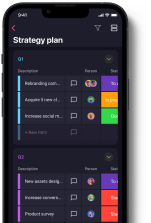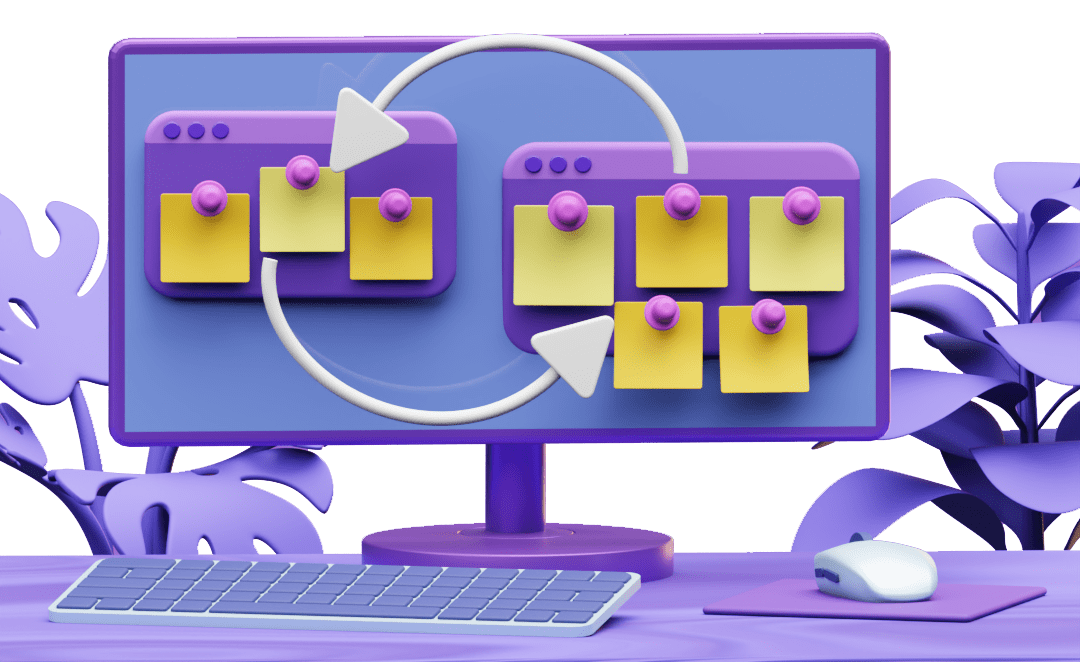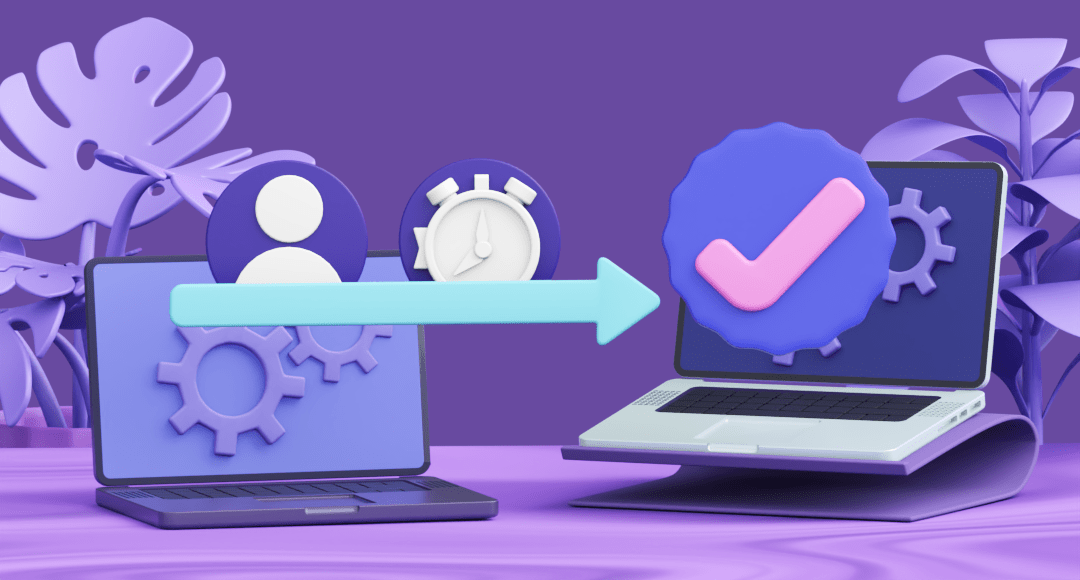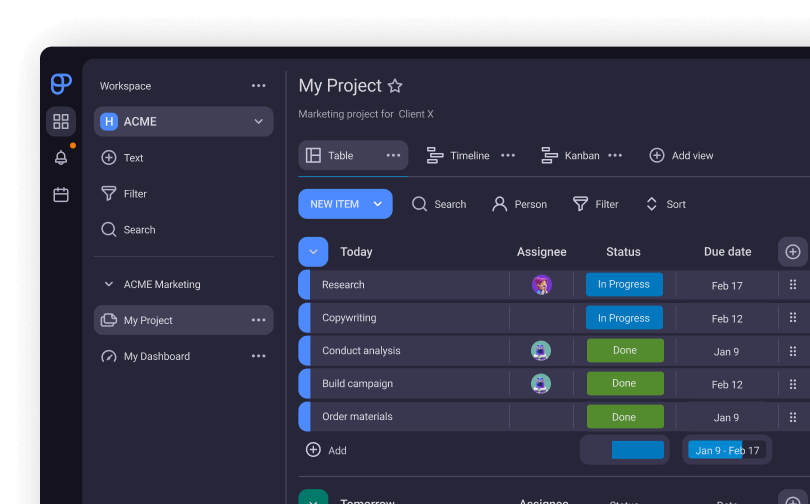20 Project Management Methodologies: An Overview
Many different types of project management methodologies, philosophies, and frameworks have been developed over the years to help us cope with the complex nature of project management.
They have been received and used with varying levels of success. Several, however, have come out on top in terms of widespread use and popularity.
Your chosen project management methodology should align with your project goals and needs. To help you make a more informed decision, our guide explains:
- What a project management methodology is,
- The difference between a methodology and a framework,
- The 20 most popular methodologies and their advantages and disadvantages,
- How project management methodologies are classified, and
- How to pick the right methodology for you.
Let’s get started!

Table of Contents
What is a project management methodology?
In the PMBOK® Guide (7th edition), a methodology is described as “a system of practices, techniques, procedures, and rules used by those who work in a discipline.”
In simple terms, a project management methodology (PMM) guides you every step of the way. It’s a structured blueprint that directs your workflow, orchestrating the way you plan, manage, and execute a project.
Many different methodologies exist, and it’s hard to say which one is truly the best. The winner does not exist precisely because every project team chooses the methodology that makes the most sense to them — and to the project in question.
What is the difference between project management methodologies and frameworks?
Project management frameworks and methodologies are often grouped together without much rhyme or reason. However, we must delineate their differences.
Methodologies have a clearly defined structure whose aim is to help us do something. They outline which steps we have to take, rules to adhere to, methods to use, and similar.
Frameworks aren’t as strict and don’t tell us exactly what we should do. Instead, they offer a set of guidelines that allow for a more flexible approach to different projects.
Generally speaking, a methodology upholds rigid practices and rules. In contrast, a framework allows for more creative changes due to its flexible guideline-based structure.
Furthermore, with clear rules in place, it’s evident that methodologies lower the risk of inconsistent outcomes and defects. The risk with using frameworks is greater, of course, as the outcome is less predictable, and the whole project is more prone to changes.
An expert we reached out to, David O’Brien, PMP-certified founder of TheProjectManagement.Expert, further clarified the difference between a methodology and a framework:

“A methodology is a set of procedures for performing a process. A framework is a set of guidelines to be considered, but not a mandate for the project manager to follow. In this way, a methodology is prescribed advice, while a framework is a set of loose suggestions.”
The blurry line between methodologies and frameworks
Some of the most popular PM methodologies today are:
- Waterfall,
- PRINCE2,
- Critical Chain Project Management (CCPM),
- Six Sigma,
- Crystal, and
- PRiSM.
As for PM frameworks, they include:
- Scrum,
- Kanban,
- Scrumban,
- eXtreme Programming (XP),
- Adaptive Project Framework (APF),
- Rapid Application Development (RAD),
- Feature Driven Development (FDD), and
- Dynamic Systems Development Method (DSDM).
Keep in mind that some approaches cannot be exactly categorized into these 2 groups. Indeed, there’s lots of disagreement regarding the classification of most of these approaches.
Agile, Lean, and Kaizen, for instance, belong in the realm of philosophies and mindsets.
Critical Path Method is a project scheduling algorithm used in project management. Meanwhile, Event Chain Methodology is a schedule network analysis technique.
Interestingly, some say that the Project Management Body of Knowledge (PMBOK) is a methodology, while others maintain it’s more of a framework. A more accurate description would be to say that it’s an industry standard for best practices in project management.
20 Popular project management methodologies and frameworks
Since the classification of most PM approaches is debatable, we’ll try to avoid further confusion by listing them all as project management methodologies.
In our list, we will go over their basic functionalities, key concepts, advantages, and disadvantages. The methodologies we will look at are:
- Agile,
- Scrum,
- Kanban,
- Scrumban,
- Kaizen,
- Lean,
- Waterfall,
- eXtreme Programming,
- PRojects In Controlled Environments (PRINCE2),
- Project Management Body of Knowledge (PMBOK),
- Critical Path Method (CPM),
- Critical Chain Project Management (CCPM),
- Six Sigma,
- Adaptive Project Framework (APF),
- Rapid Application Development (RAD),
- Crystal,
- Feature-Driven Development (FDD),
- Dynamic Systems Development Method (DSDM),
- PRiSM, and
- Event Chain Methodology (ECM).
PM methodology #1: Agile
Agile, in short: Continuous and incremental delivery of valuable working software.
According to the Agile manifesto, Agile is a “lightweight” project management approach.
When Agile was established, it was initially designed for software development. Since then, however, it has been used in other fields and industries too, for different kinds of projects.
Agile aims to facilitate effective responses to change instead of sticking to a rigid plan. The authors of this manifesto embrace the importance of modeling, documentation, and planning — but also recognize their limitations in turbulent times.
Following the basic principle of “agility,” the authors cite the most important Agile values:
- Individuals and personal interactions > processes and tools,
- Working software > comprehensive documentation,
- Customer collaboration > contract negotiation, and
- Responding to change > following a plan.
As for the specifics, we can turn to Jim Highsmith, one of the Agile manifesto signatories.
In his book Agile Project Management: Creating Innovative Products (2nd edition), he says that Agile project management usually consist of 5 stages:
- Envision — define project objectives, project constraints, and community, as well as the product vision and how the Agile team will collaborate,
- Speculate — come up with a release plan to deliver the project vision,
- Explore — keep seeking to lower risk and uncertainty while planning and delivering running tested stories,
- Adapt — review and adapt according to the results, current situation, and your performance, and
- Close — bring the project to a close and share everything you learned throughout the process.
Advantages of Agile
Several characteristics give Agile a competitive advantage. According to Agile Processes and Methodologies: A Conceptual Study, these include:
- Ability to adapt to changing environments,
- Focus on ensuring customer satisfaction,
- Minimal documentation requirement, and
- Reduced development risks, such as unexpected costs.
We talked with Michelle LaBrosse, PMP and PMI-ACP-certified CEO and founder of Cheetah Learning, about Agile and why she opted for it:

“We use Agile as it fits in our get-it-done-fast culture at Cheetah Learning. While Agile project management is best suited for software development, where the objectives of the project may change over time, we like it because of the emphasis on the “minimum viable product.” This helps us keep moving the business forward.”
💡 Plaky Pro Tip
If you’re looking for Agile project management software, check out this list and find the right fit for you:
Disadvantages of Agile
That same study highlights the disadvantages that could hinder Agile’s success, such as:
- Reliance on customer interactions,
- Lack of documentation,
- Constantly changing requirements that waste time and project resources, and
- Providing more value to managers than to developers.
Michelle LaBrosse also recognizes that Agile is not perfect:

“When we’re in a Cheetah Agile sprint, it’s all consuming for a couple of weeks until we complete our project. We don’t put people on back-to-back Cheetah Agile Projects because it’s too difficult to get other day-to-day tasks required of running the business and life in general [done]. But that is precisely what makes it so effective for achieving the project objectives.”
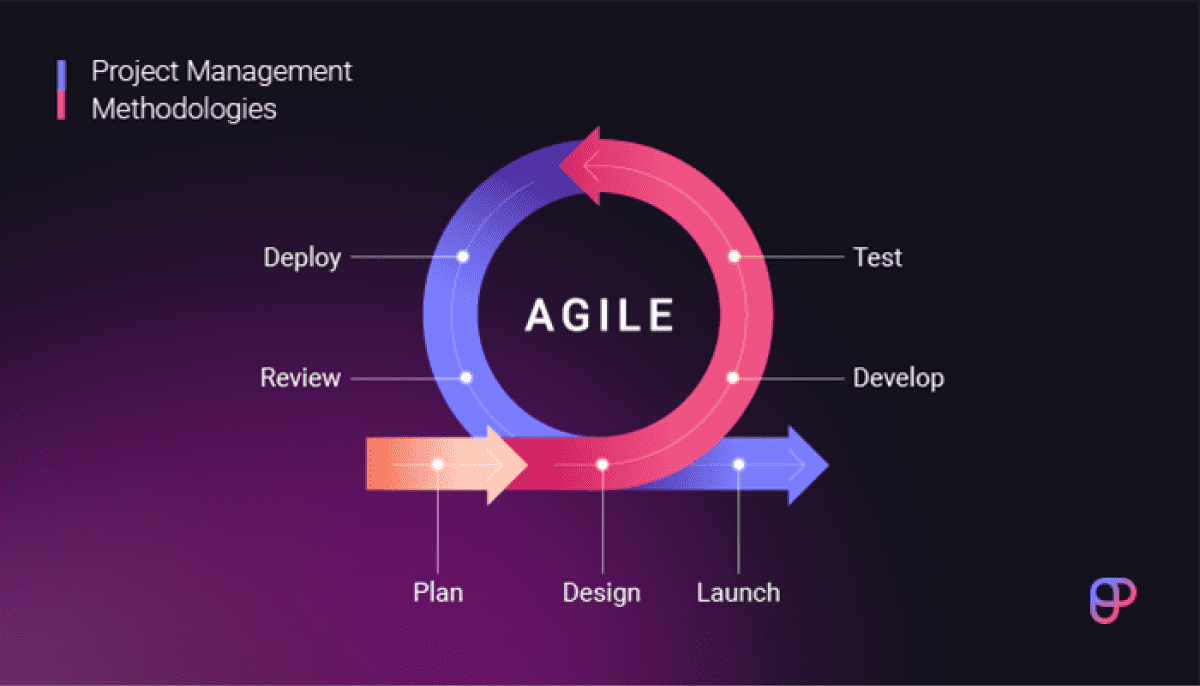
💡 Plaky Pro Tip
Interested in learning more about Agile, its values and principles, and how it compares to other frameworks? Check out our guide below:
PM methodology #2: Scrum
Scrum, in short: Incremental and responsive process that revolves around Sprints.
The 2020 Scrum guide states Scrum is “a lightweight framework that helps people, teams, and organizations generate value through adaptive solutions for complex problems.”
The foundations of Scrum theory include:
- Empiricism — highlights experience-based knowledge and learning by observing, and
- Lean thinking — focusing on essentials and not wasting time on irrelevant stuff.
The key elements of Scrum are:
- Sprints,
- the Scrum Team,
- Scrum Artifacts, and
- Scrum Events.
Sprint — a period (usually one month or less), during which a potentially releasable product is developed.
The Scrum Team consists of:
- Scrum Master — leader of the Scrum Team, responsible for the adherence to Scrum Values,
- Product Owner — manages the Product Backlog and optimizes the work of the Developers, and
- Developers — a cross-functional, self-organizing team of professionals that produces the increment.
Next, Scrum Artifacts include:
- Product Backlog — requirements the end product must meet, including the description, order, estimate, and value,
- Product Goal — a long-term objective that provides more context for the Product Backlog,
- Sprint Backlog — a real-time overview of everything the developers plan to achieve during a Sprint,
- Sprint Goal — a single Sprint objective,
- Increment — version of a product after a Sprint, a step forward in the development process, and
- Definition of Done — a formal description of an increment and its state.
The Scrum Events comprise:
- Sprint Planning — discussion around the objectives of the Sprint and Product Backlog items,
- Daily Scrum — 15-minute meeting during which Developers discuss progress and make next-day actionable plans,
- Sprint Review — evaluation of what has been achieved during the Sprint, and
- Sprint Retrospective — a meeting that concludes a Sprint during which the team discusses what was good, what was bad, and what will be improved in the next Sprint.
Advantages of Scrum
The major advantages of Scrum include:
- Continuous progress, even if requirements aren’t stable,
- Improvement of project team communication,
- Breakdown of complicated tasks into manageable chunks,
- High visibility for everyone involved,
- Shared successes among the team along the way,
- Timely increment delivery, and
- Success culture development.
Scrum is the preferred approach of David O’Brien, who had this to say about the framework:

“Scrum is falling out of favor at the moment. I believe that this is due to the fact that practitioners either apply the framework too rigidly or as an excuse to not put a proven project management methodology in place.”
“However, if you implement Scrum while applying physiological theory, then the working environment becomes a giddy playground of creativity, cooperation and self-coordination. Scrum allows for a quick feedback loop to be applied. Lessons learned in one Sprint can be applied to the next Sprint within days. No other framework or methodology can guarantee that lessons are learned and applied quite like Scrum.”
He believes that Scrum is ideal for project management:

“Most business executives find it difficult to plan, to predict, and to foresee problems that may arise on a project months or years down the line. I believe that Scrum is the perfect framework to apply to projects, as it allows for ongoing decisions to be made just at the time that they need to be.”
Disadvantages of Scrum
Scrum has a few drawbacks too, such as:
- Difficulty getting started with the framework,
- The need for a clear project roadmap and idea of what needs to be done,
- Poor performance in high-intensity, service-driven environment, and
- The need for an experienced and efficient team able to deliver results fast and in short time periods.
As a certified Scrum Master, our expert David O’Brien also knows that Scrum isn’t without fault:

“Without question, the biggest disadvantage to Scrum is the contract. The legal contract between a client and vendor needs to be crafted almost exactly to allow for the vision to be delivered within the timeframe defined and to produce the scope of work as required by the senior executives. It is definitely possible, but if adequate attention is not paid to the contract, then both parties could easily end up at odds with each other.”
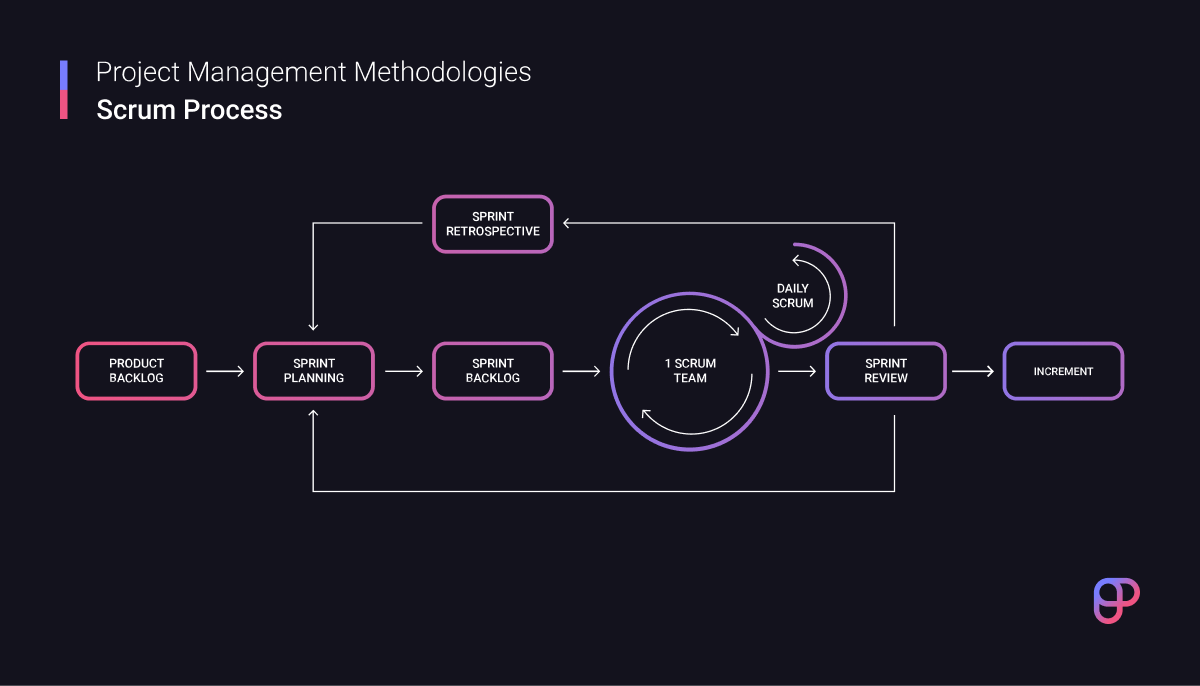
💡 Plaky Pro Tip
To learn more about Scrum and how to implement it in project management, read our guide:
PM methodology #3: Kanban
Kanban, in short: Continuous, visual representation of task item data.
The first Kanban system was developed in the automotive industry to optimally control and manage work and inventory. Essentially, it served as a way of reducing waste and coping with planned and unplanned interruptions in the product development process.
More recently, the Kanban project management approach has been adjusted for the needs of the software development industry.
According to the Agile Practice Guide, Kanban is a holistic framework whose core properties include:
- Visualizing the workflow,
- Limiting work in progress,
- Managing the flow,
- Making process policies explicit,
- Implementing feedback loops, and
- Improving collaboratively.
The most notable feature of Kanban is how it visually organizes the project workflow via the Kanban board.
This tool organizes tasks by first assigning each one with its card and details on how it should be executed.
The cards are then put into several columns, each representing their level of completeness. This way, you get continuous insight into task status and how close you are to finishing a deliverable product.
Advantages of Kanban
A systematic literature review on Kanban in software development found the following advantages of Kanban:
- Faster product delivery,
- Better quality software,
- Enhanced team member coordination and communication,
- Improvements in delivery consistency, and
- Fewer customer-reported deficits.
Disadvantages of Kanban
That same review also cited some of the shortcomings of Kanban:
- Cannot work on its own — requires additional practices,
- Hard to implement in existing company practices,
- Requires specialized training, and
- Makes it difficult to categorize tasks according to priority.

💡 Plaky Pro Tip
Our Kanban guide gives a deeper insight into Kanban project management and Kanban terms, rules, and principles. You can read it here:
PM methodology #4: Scrumban
Scrumban, in short: Just-in-time Kanban organization + Scrum iterations.
Combining some of the features of Kanban and Scrum frameworks, we get Scrumban.
According to The Scrumban [R]Evolution: Getting the Most Out of Agile, Scrum, and Lean Kanban, Scrumban “emphasizes applying Kanban systems within a Scrum context, and layering the Kanban method alongside Scrum as a vehicle for evolutionary change.”
The framework aims to balance out Scrum’s rigid nature and Kanban’s flexibility. Thus, it keeps only a few features of both of these frameworks.
For example, it keeps Scrum’s approach to work prioritization — in which work is allocated based on complexity and product demand.
However, task visualization involves the use of Kanban boards. That’s the easiest way to check for bottlenecks and track progress.
Plus, the use of Sprints is not mandatory but rather depends on the team itself.
Advantages of Scrumban
Ass. Professor, PhD Peter Ganev’s research piece on the advantages and disadvantages of using Scrumban for software development highlights the following benefits:
- Decisions are made when they are needed,
- There’s a short lead time,
- Emphasis is on continuous improvement, and
- Time and resource waste is minimized.
Disadvantages of Scrumban
Scrumban’s disadvantages include:
- A lack of defined best practices,
- Difficulty tracking individual accomplishments, and
- Limiting the project manager’s control over the project.
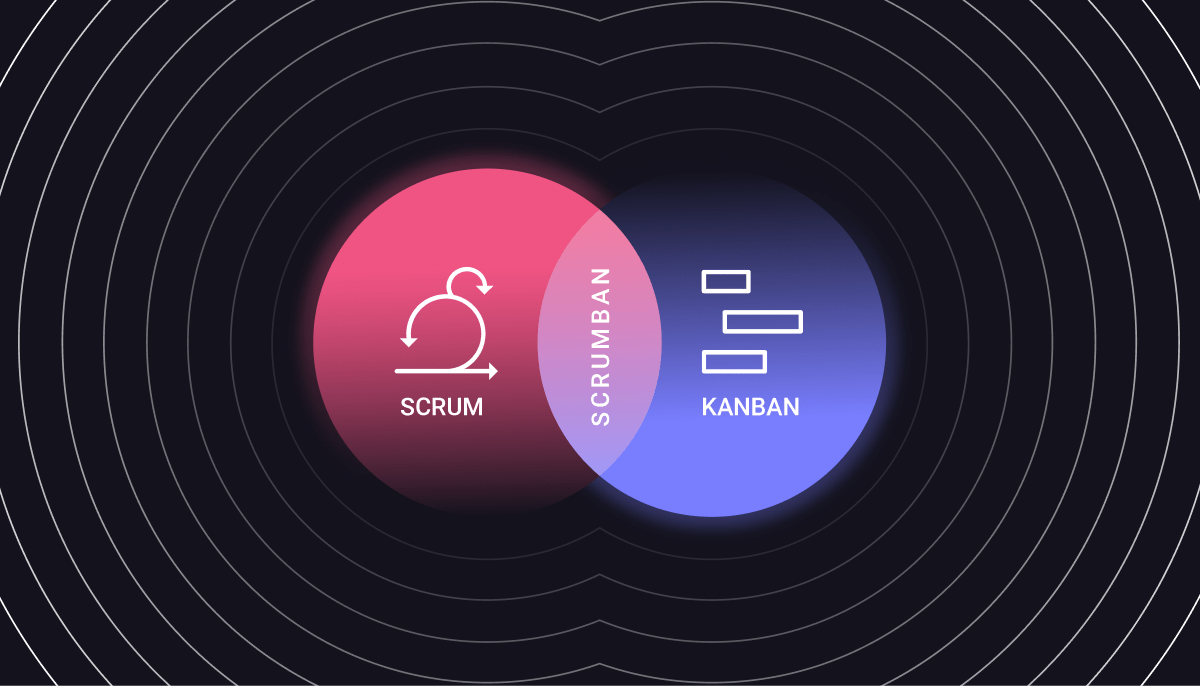
💡 Plaky Pro Tip
Check out our Scrumban guide to learn more about this framework and master its terminology:
PM methodology #5: Kaizen
Kaizen, in short: Continuous improvement in organizations that involves all team members.
Kaizen is a Japanese term that means “continuous improvement”. Essentially, Kaizen is the philosophy of continuously improving operations involving all employees.
Kaizen is not a project management methodology per se. However, it is an important business philosophy that influenced the creation of Lean and Kanban — as well as some other modern PMMs.
The 5 S of Kaizen — its key principles — are:
- Seiri — Sort and prioritize tasks,
- Seition — Straighten and organize items and documents,
- Seiso — Shine the workplace, keep it clean,
- Seiketsu — Standardize rules and policies, and
- Shitsuke — Sustain and adhere to the rules, make the new processes habitual.
Advantages of Kaizen
According to a paper on Kaizen as a global business philosophy, Kaizen benefits include:
- Improved quality, productivity, and efficiency,
- Lower costs and fewer losses,
- Quicker product delivery,
- Higher level of customer satisfaction, and
- Greater job security.
Disadvantages of Kaizen
The disadvantages of the Kaizen approach are as follows:
- Difficulty implementing into existing systems,
- Implementation requires extensive staff training, and
- Potential staff demoralization.
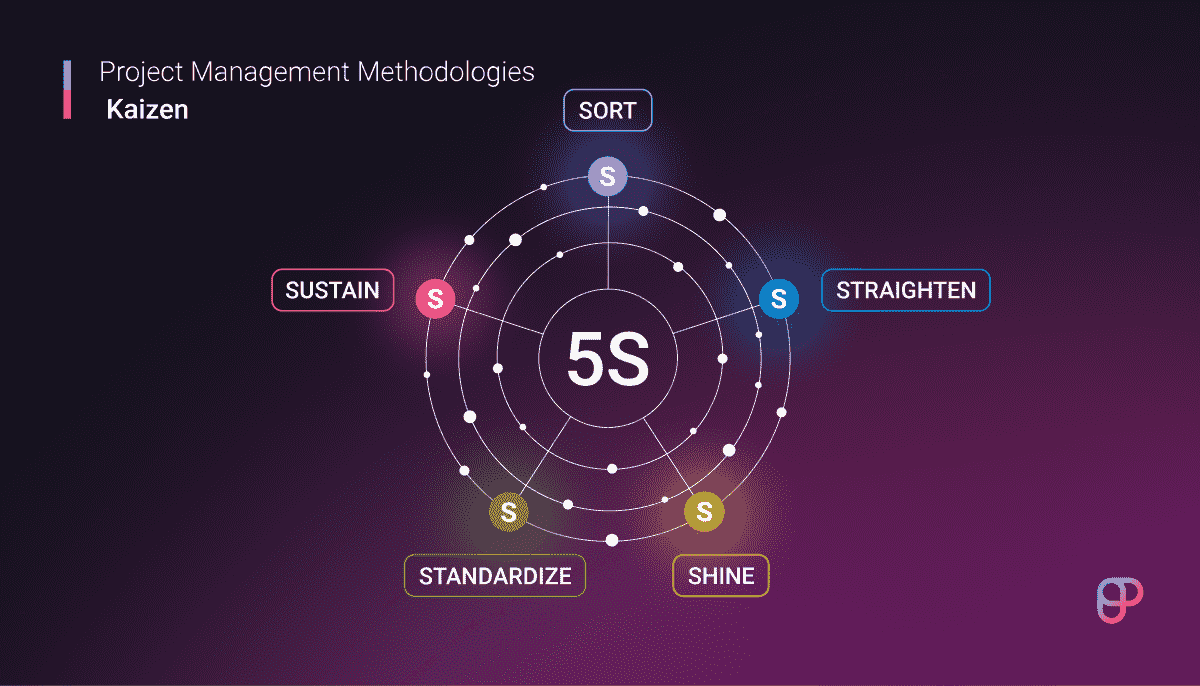
PM methodology #6: Lean
Lean, in short: Careful planning to avoid reworking steps and unnecessary expenses.
Lean is based on the business philosophy Toyota developed in the wake of World War II. It prioritizes careful planning and consideration of each step of the project production process.
If properly used, Lean techniques should lead to waste reduction, a greater profit margin, and higher level of customer satisfaction.
According to Lean Thinking: Banish Waste and Create Wealth in Your Corporation, the 5 core principles of Lean are:
- Identify value — define what the customer wants from a specific product,
- Map the value stream — consider all the steps and processes that lead to delivering the final product,
- Create flow — make sure the flow is smooth, without any bottlenecks, interruptions, or delays,
- Establish pull — an improved flow means you can deliver products as needed and not keep an expensive inventory, and
- Seek perfection — keep perfecting your processes and embrace lean thinking in full.
Advantages of Lean
Some of the most defining advantages of Lean are as follows:
- Less time wasted on irrelevant tasks and issues,
- More focus given to truly important project activities,
- Higher level of quality and customer satisfaction,
- Greater sense of purpose for the team, and
- Cost reduction.
Disadvantages of Lean
Some of the downsides of Lean include:
- Little “buffer” room, which leads to errors having devastating consequences,
- Higher implementation costs and lots of overhead when switching to Lean,
- Required training for inexperienced or change-resistant staff,
- Inconsistent delivery in case of inventory problems, and
- Employee dissatisfaction due to expecting perfection.
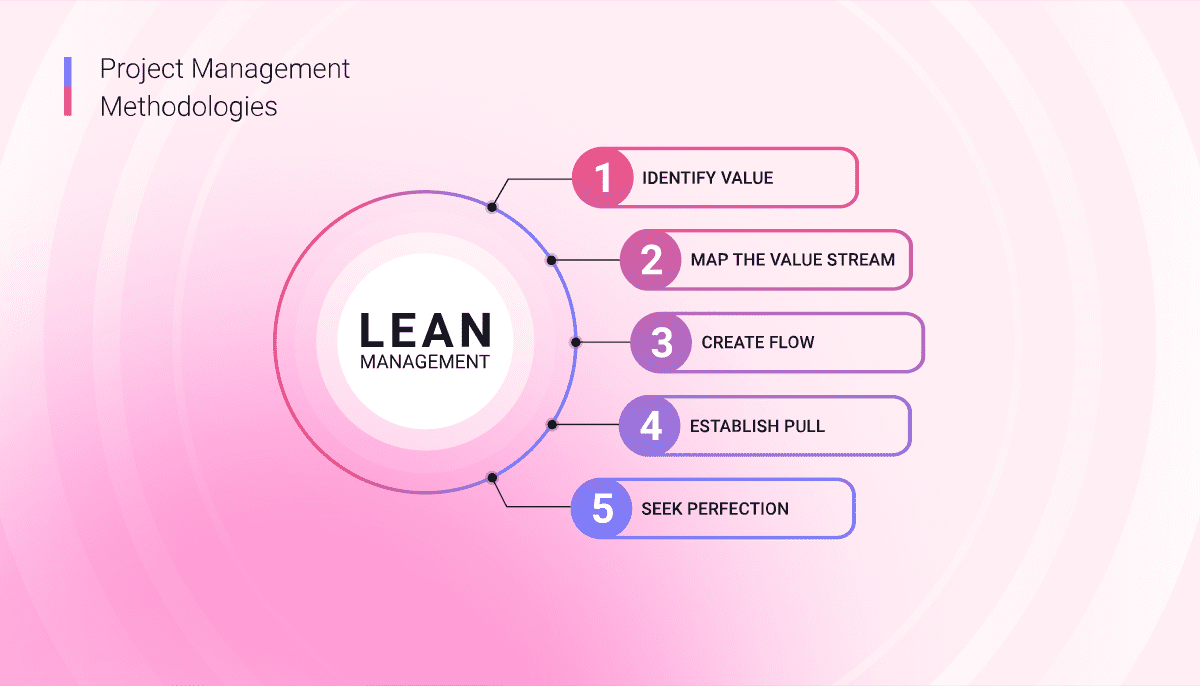
💡 Plaky Pro Tip
Our guide to Lean provides a deeper insight into the Lean principles, and in particular, the types of different waste it aims to eliminate to map the value stream. Check it out here:
PM methodology #7: Waterfall
Waterfall, in short: Each step of the project process needs to be completed before continuing to the next one.
Waterfall has a basic structure of one part of the project process leading (cascading) into another — thus the waterfall imagery.
The basic nature of this methodology is not flexible. Waterfall relies on all previous steps being completed perfectly, before going onto the next one.
This also means that sudden changes are not anticipated. The purpose of creating a detailed plan before starting the project is to cover all bases. So, if some changes do have to happen, their implementation can be time-consuming and often quite costly.
The stages of the Waterfall methodology are:
- Requirements — a conceptual stage during which you find out what the client wants,
- Design — a planning stage where you work out a comprehensive project plan,
- Implementation — the stage during which all the non-conceptual work happens,
- Verification — the testing stage where you get client input and work out any issues, and
- Maintenance — the stage that encompasses implementing necessary changes to ensure long-term, continuous use of the product.
Advantages of Waterfall
A study from 2021 on the differences between Agile and Waterfall project management highlights the following advantages of Waterfall:
- Fixed processes with clearly defined roles and responsibilities,
- Systematic and well-documented planning, and
- Easier predictions of team’s capacity and project progress.
An expert we talked to, Jamie Mitri, PMP-certified founder and CEO of Moss Pure, sees the Waterfall stages as gates we have to unlock to go through:

“This methodology is separated out into phases, and each phase has a gate, meaning that you cannot go to the next phase without completing the previous gate — and, most importantly, getting sign-off from key stakeholders.”
Disadvantages of Waterfall
That same study discovered some disadvantages of Waterfall:
- Difficulty getting all the requirements in order at the start of the project,
- Higher chance of mistakes due to incorrect project planning and abstract specifications,
- Expensive error correction,
- Intense documentation and planning,
- No customer or user feedback throughout the process, and
- Rigid project phase sequence.
Our expert, Jamie Mitri, wouldn’t exactly recommend Waterfall for all types of projects:

“Because of the quick nature of software production, it’s best to track development and defects using the Agile method. Several defects and changes can occur in software development over a small period of time, so the Agile method uses timed sprints where the group concentrates on one goal at a time.”
However, she argues that it sometimes makes sense to combine the Waterfall and Agile approaches:

“If you are creating a system where hardware and software are combined, the best approach is to use Waterfall for the hardware aspect, and Agile for the software aspect, or combine the two methodologies [according] to the project and team needs.”
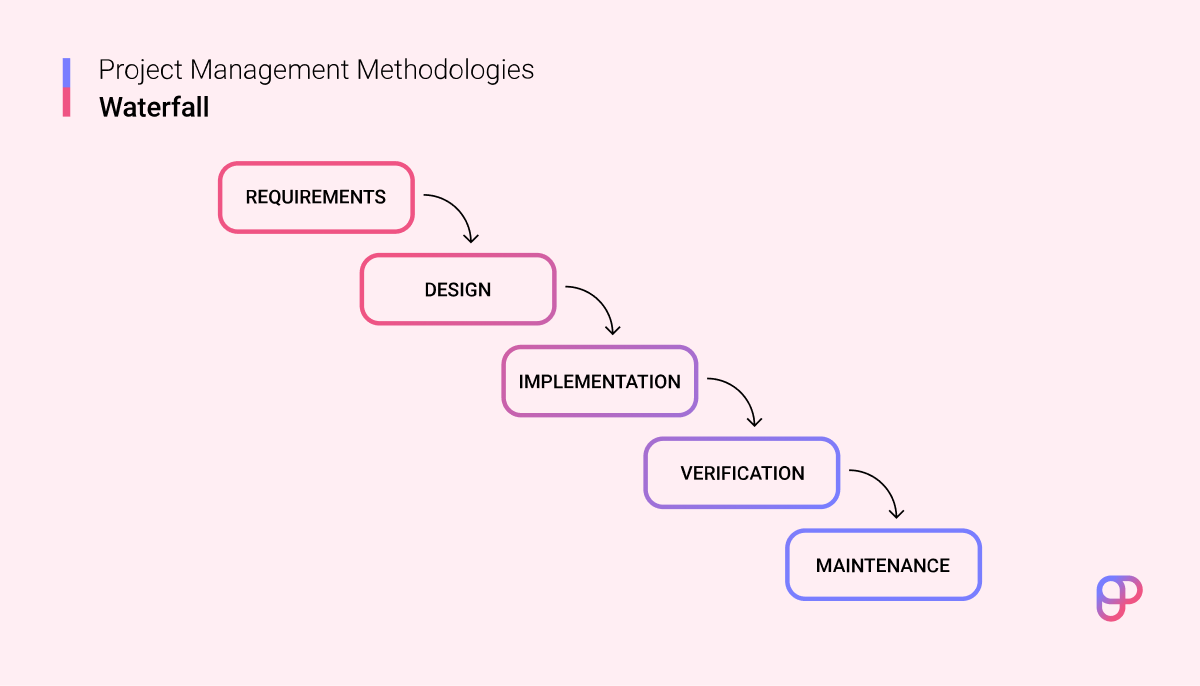
💡 Plaky Pro Tip
Our guide to the posterboy of PMMs gives a more detailed insight into the Waterfall methodology and how you can implement it in your projects. Read it here:
PM methodology #8: eXtreme Programming (XP)
eXtreme Programming, in short: Taking all the pros of traditional approaches to the extreme.
eXtreme Programming is a framework designed to improve quality while staying responsive to any changes the customer requires.
Similar to other agile frameworks, XP consists of shorter cycles of development. It also mainly focuses on business value, which is achieved through small, fully integrated software releases that fulfill all client requirements.
The name of this methodology comes from the idea that beneficial elements of traditional software engineering are taken to the extreme.
Some of the most important practices of XP are:
- Refactoring,
- Pair programming,
- Continual testing, and
- The use of class-responsibility-collaboration cards (CRC).
According to Agile Alliance, the 5 values of XP are:
- Communication — engage preferably in face-to-face discussion aided by some sort of a drawing mechanism,
- Simplicity — avoid waste and keep the design simple so that you can easily maintain and revise it as necessary,
- Feedback — accept constant feedback to learn what you can improve and revise,
- Courage — nurture courage to keep your team’s interests in check, know when to stop and try again, and accept and respond to feedback, and
- Respect — ensure mutual respect throughout your team to aid communication.
Advantages of eXtreme Programming
According to a paper on Agile software development methodologies and practices, the advantages of using eXtreme programming are shown in a few industry case studies. They include:
- Improved quality,
- Productivity boost,
- Higher team morale, and
- Greater customer satisfaction.
Disadvantages of eXtreme Programming
The same paper mentions the disadvantages of eXtreme Programming:
- Might be ideal only for small, colocated teams and non-critical software development,
- Inherent documentation de-emphasis,
- Difficulty transitioning to pair programming and test-driven development practice, and
- Time-consuming and stressful customer interactions.
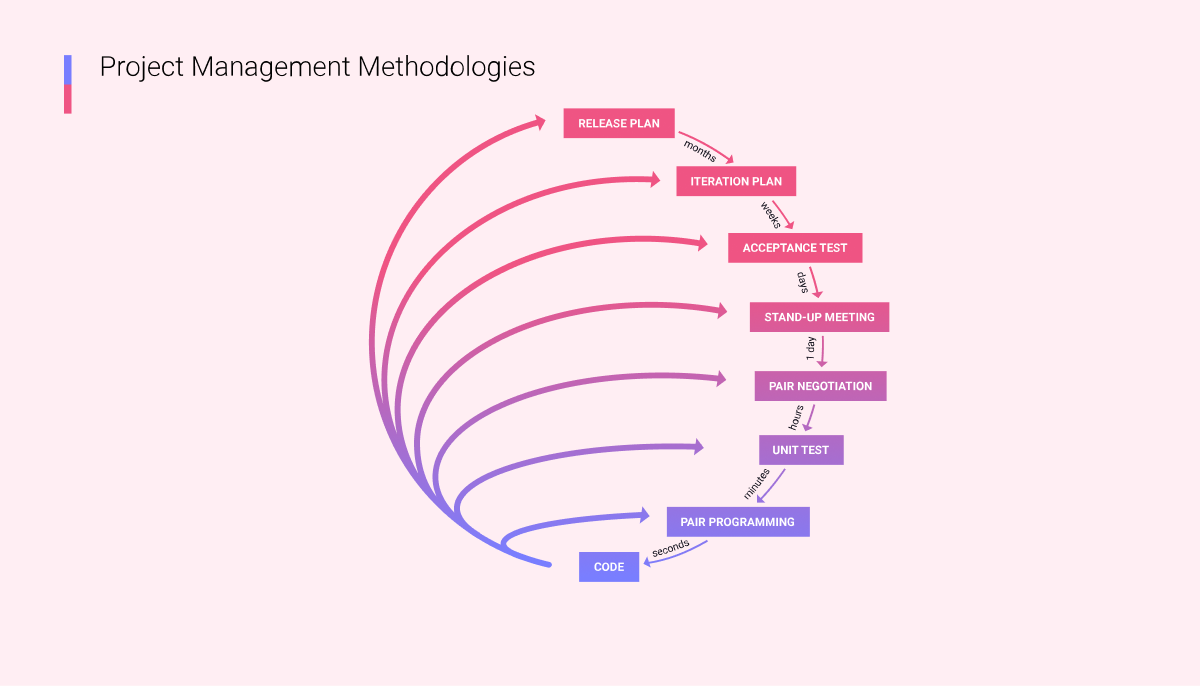
PM methodology #9: PRojects In Controlled Environments (PRINCE2)
PRINCE2, in short: A highly structured, all-encompassing approach to project management.
The story of PRINCE2 started with PROMPT, a private sector framework, which was licensed by the UK government.
The government was interested in making an IT project management method. They made a few adjustments to the PROMPT II module and called the variation PRINCE.
After its release, PRINCE slowly became more widely adopted. However, it was later deemed too rigid and unsuitable for smaller projects.
This prompted the development of PRINCE2 (short for PRojects In Controlled Environments), a generic project management method.
This methodology is based around 7 main themes. They are:
- The existence of a business case,
- Organization,
- Quality in project environment,
- Planning,
- Risk management,
- Change control, and
- Progress tracking.
The 7 PRINCE2 processes are:
- Starting up a project,
- Project initiation,
- Directing the project,
- Stage control,
- Product delivery management,
- Managing stage boundaries, and
- Project closing.
PRINCE2 is also centered around the following 7 basic principles:
- Continuous business justification,
- Learning from experience,
- Defining roles and responsibilities,
- Splitting the project process into manageable stages,
- Establishing the limits of delegated responsibilities,
- Focusing on products, and
- Adapting to the environment.
The implementation of PRINCE2 requires in-depth knowledge of all of these elements.
Advantages of PRINCE2
Some of the most important advantages of the PRINCE2 methodology are that:
- It’s a flexible methodology that can be adapted to any sort of project,
- The project roles are clearly communicated,
- It has a well defined project scope,
- There’s an official certification, and
- It pairs well with PMBOK.
Disadvantages of PRINCE2
As for the disadvantages of PRINCE2, they are as follows:
- It fails to provide actual practical tools and techniques,
- It requires extensive documentation, and
- It requires plenty of experience or training for efficient implementation.
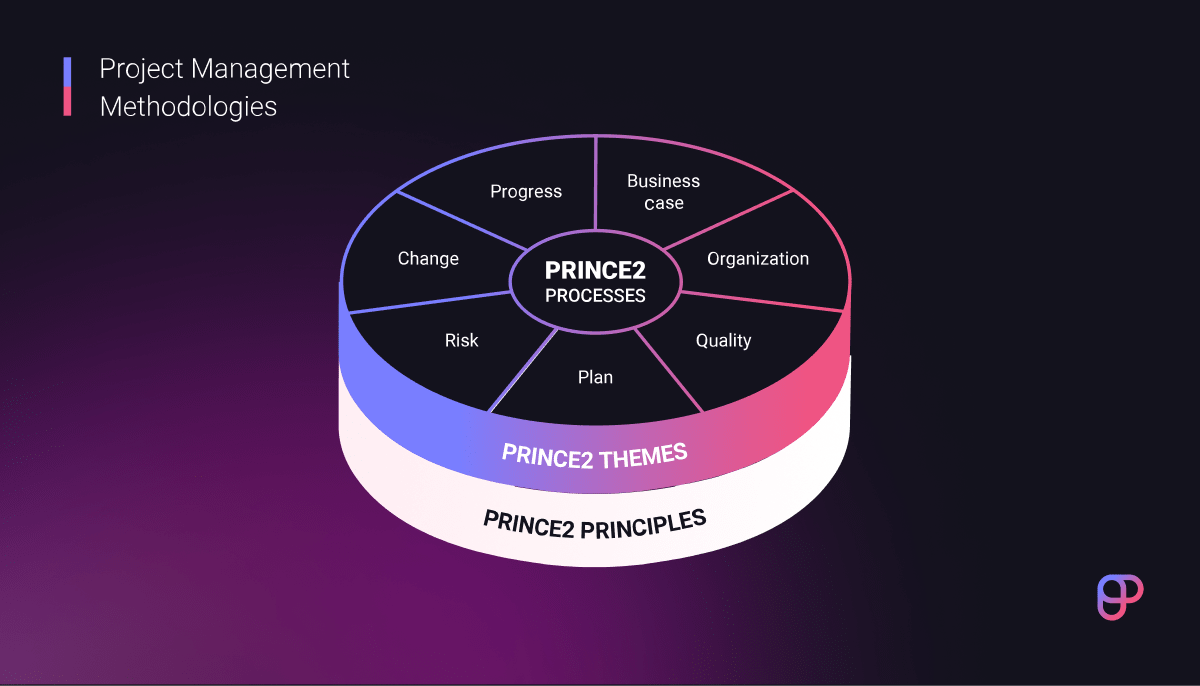
💡 Plaky Pro Tip
To learn more about PRINCE2 project management methodology, check out this guide:
PM methodology #10: Project Management Body of Knowledge (PMBOK)
PMBOK, in short: The standard for project management best practices.
Developed by the Project Management Institute, PMBOK is short for Project Management Body of Knowledge. It is the international standard of best practices in project management.
PMBOK is not a methodology but rather a body of knowledge that details specific tools and techniques used in project management. Certain parts of PMBOK overlap with PRINCE2, so these 2 can also be used in tandem.
PMBOK relies on 5 process groups:
- Initiating,
- Planning,
- Executing,
- Monitoring and controlling, and
- Closing.
PMBOK is also defined by these 10 knowledge areas, for which it provides industry-approved guidelines:
- Project integration management,
- Project scope management,
- Project time management,
- Project cost management,
- Project quality management,
- Project resource management,
- Project communication management,
- Project risk management,
- Project procurement management, and
- Project stakeholder management.
The latest version of PMBOK is the 7th edition released in 2021.
Advantages of PMBOK
Notable advantages of PMBOK are as follows:
- It is a recognized standard for project management best practices,
- It helps companies standardize processes,
- Each step is well documented, and
- It is a straightforward approach.
Disadvantages of PMBOK
Here are some of PMBOK’s drawbacks:
- It must be adjusted to the project size,
- It’s time-consuming and thus potentially demotivating for the staff, and
- It may require a larger team to cover all of the knowledge areas.
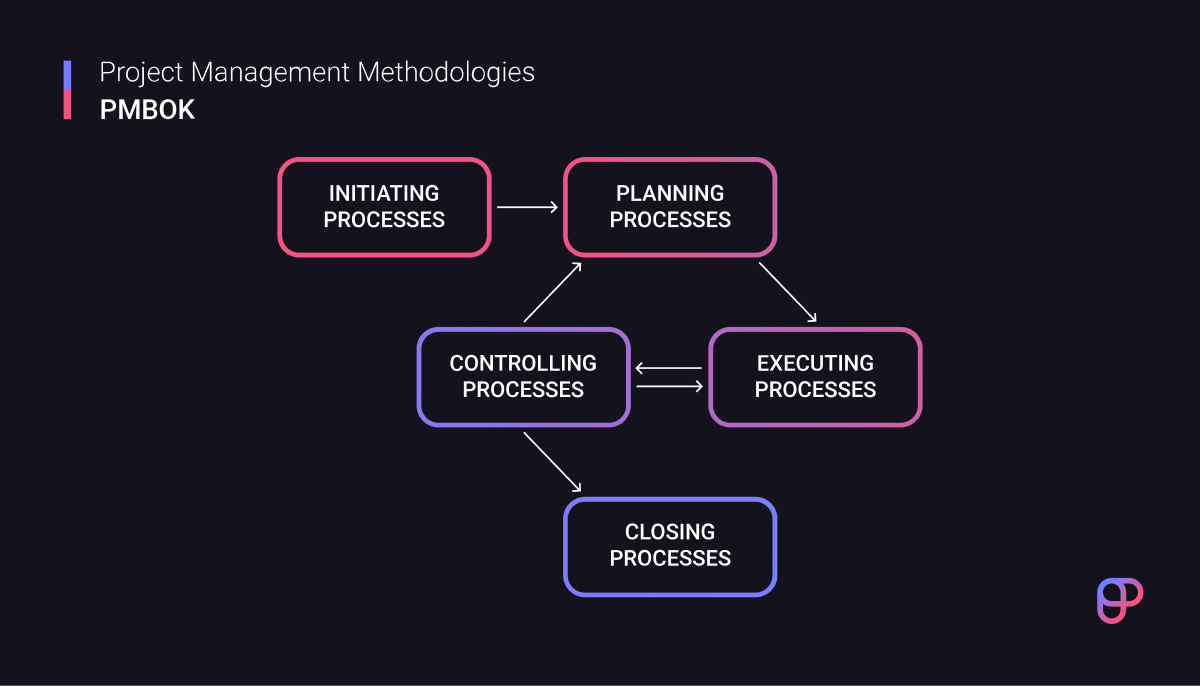
PM methodology #11: Critical Path Method (CPM)
CPM, in short: Calculate the critical path that leads to project completion to combat inefficient scheduling.
The Critical Path Method (CPM) is a project scheduling algorithm developed way back in the 1950s. Its purpose is to show us the longest sequence of dependent tasks that needs to be done to finish a specific project.
In project management, we can use CPM to calculate the shortest conceivable deadline for any project. This is done by identifying the sequence of tasks that will take the longest time to complete — the critical path.
For the most part, CPM is useful for visually representing the most efficient order in which tasks can be executed.
To find the critical path of a certain project, we have to:
- List and specify each project activity — these can be drawn from our work breakdown structure (WBS),
- Sequence them according to task dependencies — this step helps us not only see which tasks depend on each other but also which ones can be done in parallel with other tasks,
- Draft a network diagram, i.e., a graphic representation (a flowchart, for instance) of the project activities — we draw a box for each activity and connect the boxes with arrows, which represent task dependencies,
- Make task estimations — we have to estimate how much time each activity might take. This can be done by relying on industry standards, past experience on similar projects, or by “guesstimating” based on our expertise, and
- Identify the critical path — we finally calculate the path based on the longest sequence of dependent tasks. This includes identifying all the possible paths and calculating how long they’d take to complete. The longest one is the critical path.
Advantages of Critical Path Method
The key advantages of the Critical Path Method include:
- Practical project visualization,
- More effective scheduling of project activities and resource management,
- Easier project monitoring and scope creep management, and
- Better prioritization and risk detection through the use of total float.
Disadvantages of Critical Path Method
The Critical Path Method comes with a few disadvantages too:
- It’s not suitable for overly creative or unpredictable projects,
- It doesn’t take into account staff and resource availability,
- It’s difficult to estimate how much each activity would take to complete,
- It could be too complicated to apply on larger projects, and
- It requires precise calculations and detailed research, all of which can succumb to simple human error.
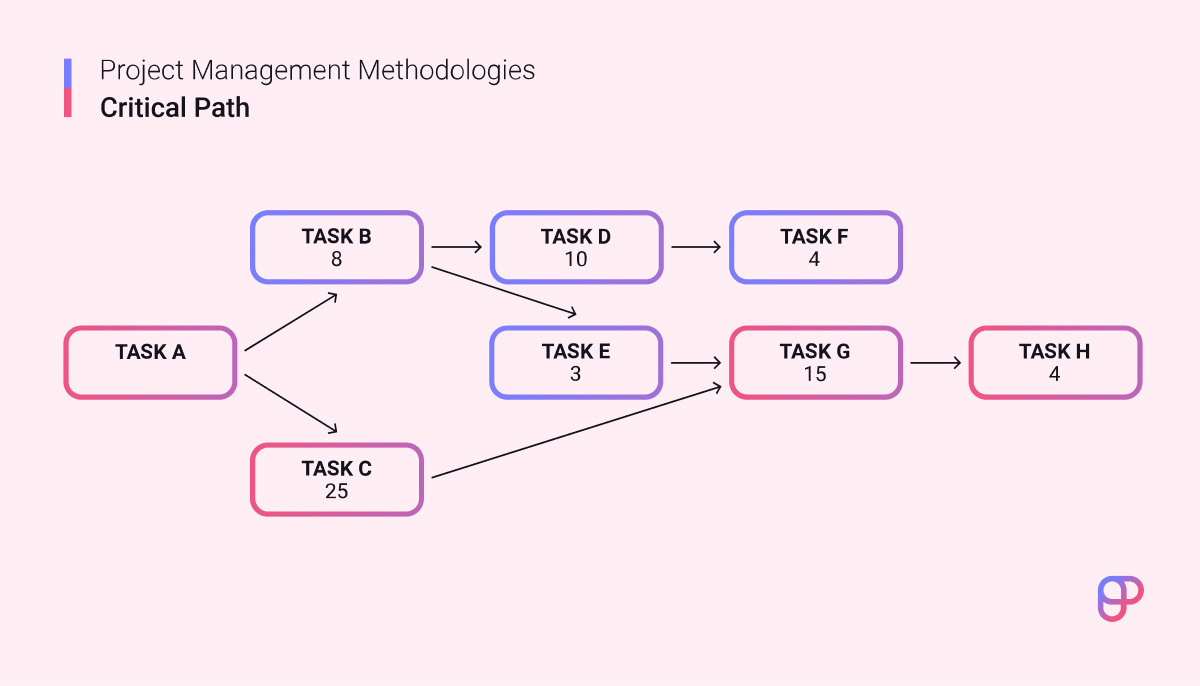
💡 Plaky Pro Tip
If you want to learn more about Critical Path Method, its terminology, and how to calculate it, check out the guide below:
PM methodology #12: Critical Chain Project Management (CCPM)
CCPM, in short: Manage resources by predicting interruptions and uncertainties.
Critical Chain Project Management (CCPM) entails planning and managing the resources that go into accomplishing project goals.
This approach is based on efficient resource distribution. Its goal is to maintain resource (people, the equipment, the physical space, etc.) availability and prevent student syndrome.
Flexibility is the crucial ingredient for efficiently calculating the necessary resources. CCPM remains flexible by introducing 3 types of resource buffers:
- Project buffers — extra time added in to preserve the project completion date,
- Feeding buffers — added between the feeding (non-critical) and critical chain so that the delays in the former don’t affect the latter, and
- Resource buffers — just-in-case resources you have readily available if the critical chain needs them (e.g., more staff, extra equipment, etc.).
Critical Path Method and Critical Chain Project Management may seem similar, but there’s a crucial difference.
CPM primarily focuses on tasks and their duration, but assumes that resources will be available when necessary.
In contrast, CCPM takes resource availability into account as well to create a more realistic schedule.
Managing projects with CCPM includes these 4 basic steps:
- Identify the critical path,
- Consider resource constraints and plan out resource utilization,
- Add the buffers, and
- Keep distractions at bay and focus on the critical chain.
Advantages of Critical Chain Project Management
The commonly cited advantages of Critical Chain Project Management include:
- Timely project completion,
- Greater scheduling reliability,
- More optimal resource utilization, and
- Higher level of team collaboration.
Disadvantages of Critical Chain Project Management
Some of the major disadvantages of CCPM include:
- Challenging implementation due to lots of planning and coordination,
- Potentially inaccurate task duration estimation,
- No objective basis for calculating the buffer sizes, and
- No proactive risk management throughout the process (only reactive, i.e., buffers).
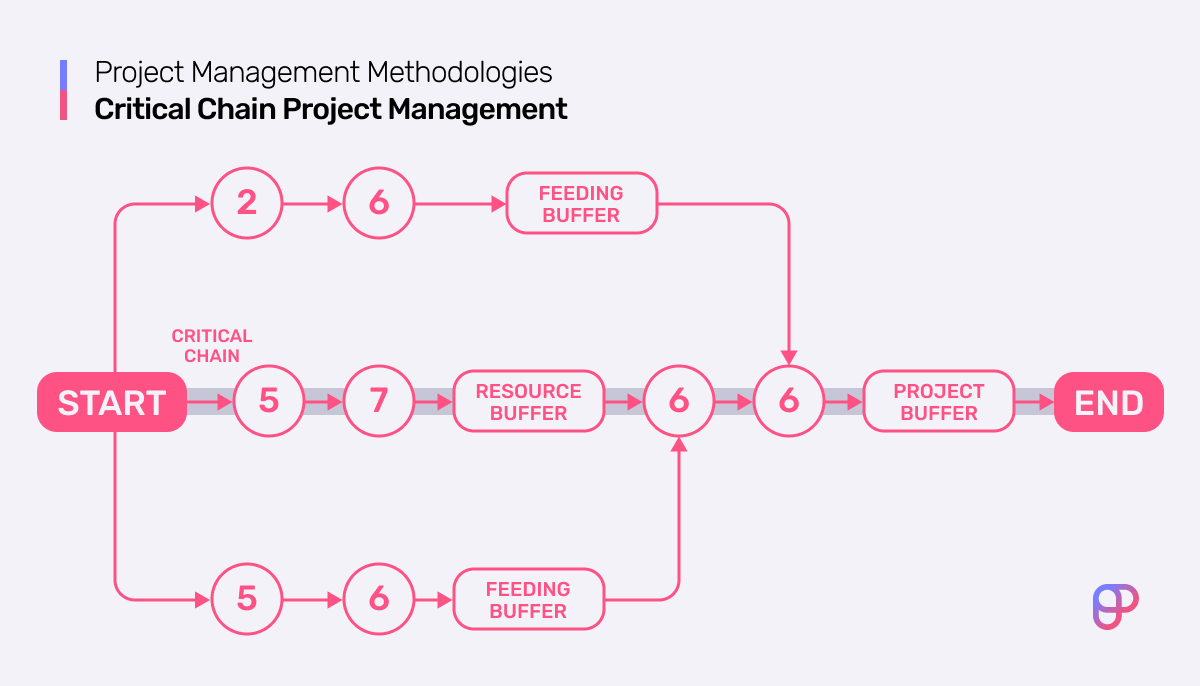
💡 Plaky Pro Tip
Learn more about Critical Chain Project Management and how to implement it in our guide below:
PM methodology #13: Six Sigma
Six Sigma, in short: Using data to eliminate waste and defects.
Six Sigma is a methodology that aims to improve business processes by using statistical data to prevent development defects.
At its core, Six Sigma is a combination of tools businesses can use to make improvements to their development cycles. These tools include the Pareto chart, the 5S system, and the 5 Whys, just to name a few.
According to Six Sigma: A Complete Step-by-Step Guide, some of the common Six Sigma ideas include:
- Customer-focused improvement,
- Continuous process improvement,
- Variation and how to reduce it,
- Waste elimination,
- People equipping, and
- Process control.
We can also discern 2 different Six Sigma approaches:
- DMAIC — Define, Measure, Analyze, Improve, and Control, and
- DMADV — Define, Measure, Analyze, Design, and Verify.
The DMAIC approach is the standard used by most Six Sigma practitioners and is applied to already existing processes.
Meanwhile, the DMADV approach is all about designing a new process, service, or product that fits the customer’s needs.
Six Sigma practitioners can get certified to prove they have practical knowledge of the methodology. The levels of Six Sigma certification are:
- White belt,
- Yellow belt,
- Green belt,
- Black belt, and
- Master black belt.
Advantages of Six Sigma
Some of the most important pros of Six Sigma include:
- Improved output quality and value,
- Optimized and continuously improving company processes,
- Improved customer satisfaction, and
- Easy identification of potential problems.
Disadvantages of Six Sigma
Some of the disadvantages of Six Sigma might be that:
- It’s time-consuming due to the large amount of data it generates,
- Implementing its protocols can quickly get expensive,
- It requires support and buy-in at all organizational levels, and
- It calls for consistent and accurate data streams.
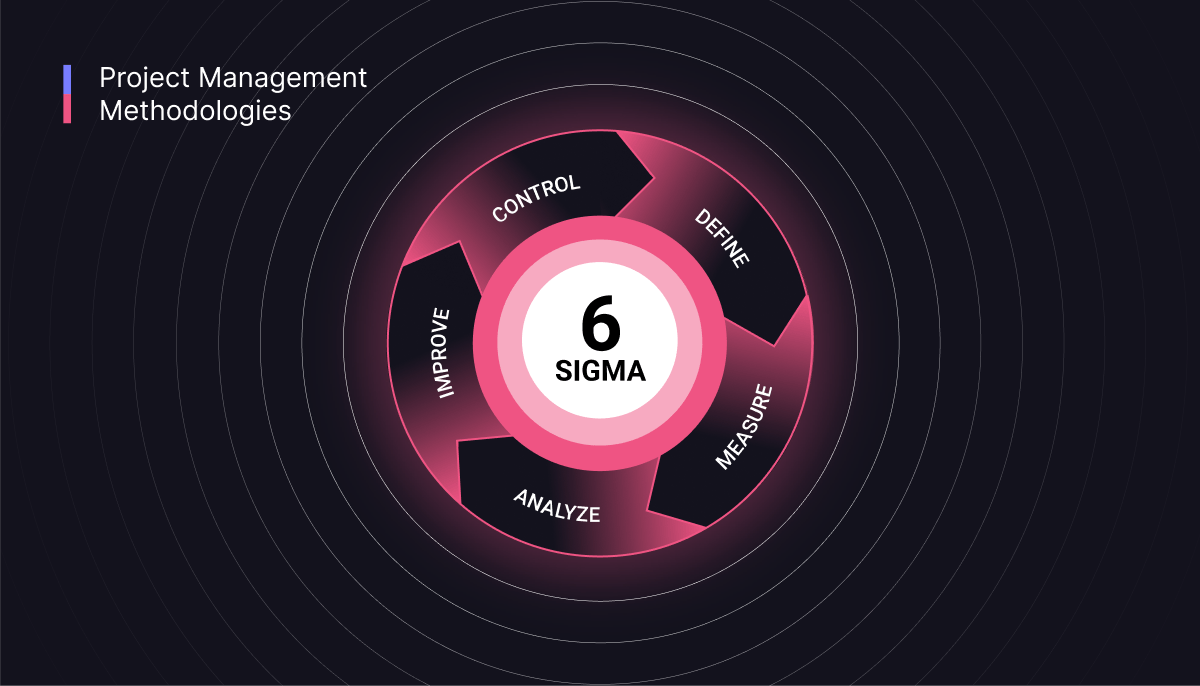
💡 Plaky Pro Tip
The Six Sigma methodology has many other aspects to it — but it isn’t that difficult to master. Find out more about Six Sigma, its principles, and how it works in the guide below:
PM methodology #14: Adaptive Project Framework (APF)
APF, in short: Flexible phases in the project development cycle.
The Adaptive Project Framework (APF) is a framework that focuses on “expecting the unexpected” in the software development process.
The key point to remember about this approach is that, to gradually improve, the team has to learn by doing.
All the decisions and results are re-evaluated throughout the project. Thus, the development team is able to not only nurture their flexibility but also continue learning.
The central figure of this approach is the client. The client controls the tempo of the project — until they’re satisfied, the team cannot move on to the next step.
APF is organized into 5 phases. Each phase aims to facilitate a flexible approach to the project.
Here’s a breakdown of the APF phases and their activities:
Phase #1: Project scope
- Identify Conditions of Satisfaction (CoS),
- Outline Project Overview Statement (PoS),
- Prioritize requirements,
- Create Work Breakdown Structure (WBS), and
- Prioritize scope triangle.
Phase #2: Cycle plan
- Define tasks from the WBS,
- Establish and outline task dependencies,
- Group and assign tasks to the team, and
- Come up with a work schedule.
Phase #3: Cycle build
- Start work, monitor progress, and make adjustments to the cycle build,
- Bring the cycle to a close at a predetermined completion time,
- Move incomplete (pending) tasks to the next cycle,
- Note change requests, improvement ideas, and other feedback, and
- Track and record problems.
Phase #4: Client checkpoint
- Give the client a chance to thoroughly review the latest functionality,
- Schedule adjustments or corrections, and
- Keep repeating the cycle until the project is finished.
Phase #5: Final review
- Considere the successes and failures of the project,
- Note the lessons learned along the way, and
- Define future improvements.
Advantages of Adaptive Project Framework
Here are some of the advantages of Adaptive Project Framework:
- Improved customer satisfaction due to meaningful client involvement,
- Lots of room for assessment and feedback,
- Flexible enough to accommodate various types of projects,
- The focus is on constant improvement and openness to adjustments.
Disadvantages of Adaptive Project Framework
Some of the disadvantages of Adaptive Project Framework is that:
- It can be tricky to manage due to its flexibility,
- There’s more overhead because of the frequent check-ins,
- It makes it difficult to predict the outcome,
- Client interference puts pressure on the project timeline and budget,
- It can lead to scope creep and wasted resources.
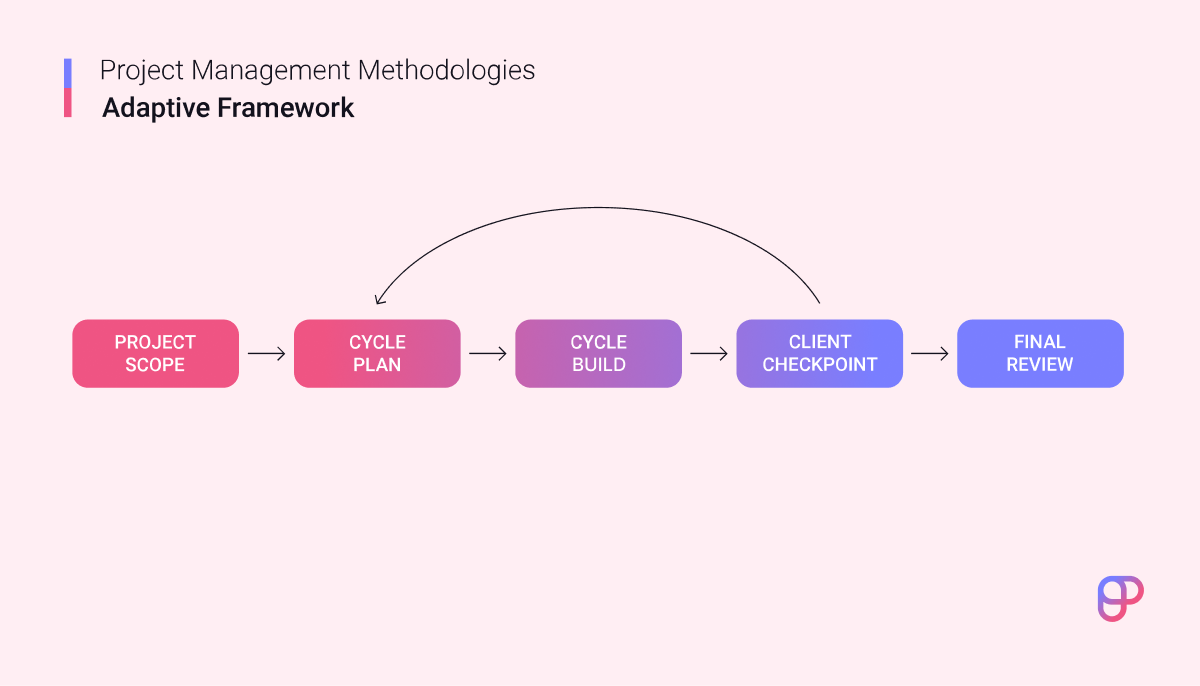
PM methodology #15: Rapid Application Development (RAD)
RAD, in short: Focused on ongoing application development.
Rapid Application Development (RAD) was developed in the 1980s for the needs of the growing software development industry. It is an agile framework that emphasizes ongoing product development.
RAD is a more dynamic approach to software development that relies on shorter project phases to realize benefits faster.
Better yet, it delivers a functional version of the requested solution with each iteration. Thus, it’s also one of the fastest ways of building functional working prototypes.
Instead of following a strict plan, the key steps of RAD include:
- Defining project requirements,
- Building a prototype,
- Rapid construction and collecting feedback, and
- Testing and deployment.
Some of the most important characteristics of this approach are as follows:
- Smaller, integrated development teams,
- Short, cyclical, and dynamic development phases,
- New releases are working systems with actual functionalities the client requested,
- Concurrent task and activity performance, and
- Fast, incremental changes.
Advantages of Rapid Application Development
The advantages of the Rapid Application Development model include:
- Faster project delivery,
- Consistent client feedback,
- Risk reduction,
- Cost reduction,
- Higher level of productivity, and
- Clearly visible continuous progress.
Disadvantages of Rapid Application Development
As for the disadvantages, they are as follows:
- Requires highly skilled, smaller teams and strong team collaboration,
- Only suitable for smaller projects that require fast turnaround times,
- The need for consistent user feedback can lead to delays, and
- Requires modular systems and a high level of stakeholder commitment.
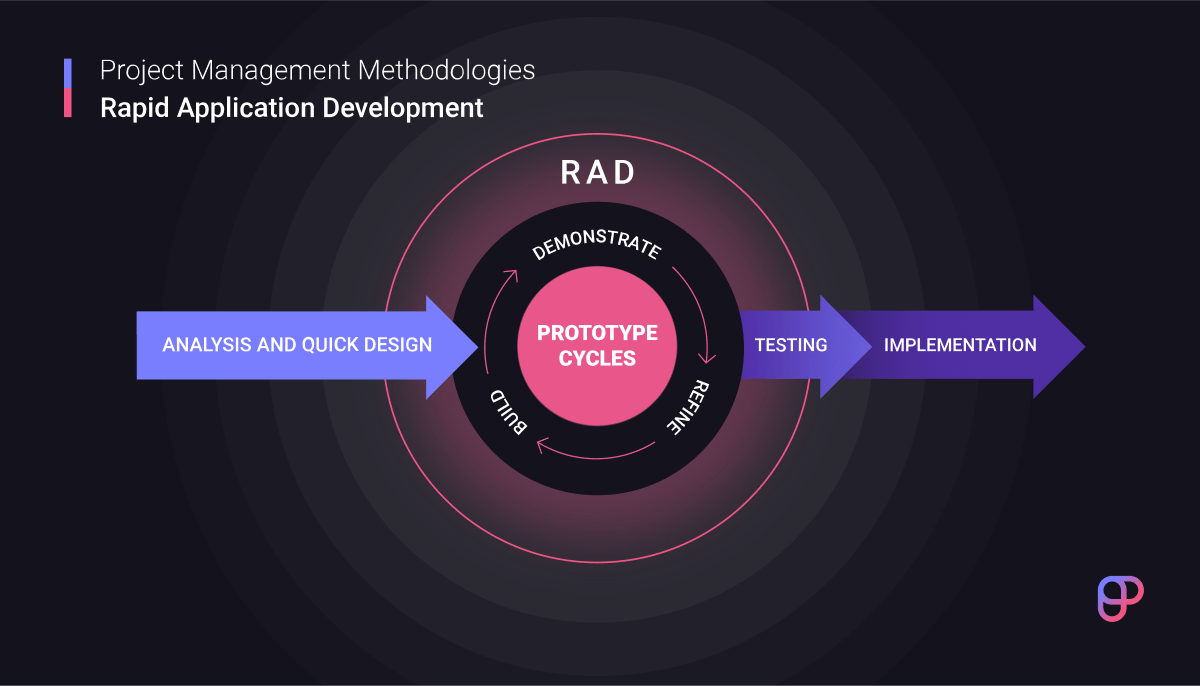
PM methodology #16: Crystal
Crystal, in short: Human-powered, lightweight, self-adapting approaches to project management.
Crystal is a family of methodologies originated by Alistair Cockburn, one of the signatories of the Agile Manifesto.
Though it doesn’t have a formal structure, working within a Crystal methodology involves these 7 basic principles:
- Frequent delivery — Teams should regularly release new codes and projects to ensure they’re building something someone actually needs.
- Reflective improvement — Learn from past experiences to improve certain actions in the future.
- Consistent communication — Small teams should co-work in the same room to improve creativity and development and practice osmotic communication. In his book Crystal Clear: A Human-Powered Methodology for Small Teams, Alistair Cockburn defines osmotic communication as the way “information flows into the background hearing of members of the team so that they pick up relevant information as though by osmosis.” Larger teams can practice closed-loop communication. Face-to-face communication is also greatly encouraged.
- Personal safety — There should be a safe environment for all team members to take part in discussions and give their suggestions.
- Focus on work — All involved should know what the project tasks are, what’s expected of them, and which project goals they’re pursuing.
- Access to expert users — Experts and real users should be readily available to give the team the necessary feedback.
- Technical environment — Teams should have access to configuration and testing tools to do timely adjustments early in the development process.
The Crystal methodologies are broken down into different color groups based on team size, such as:
- Clear — 6 or fewer employees,
- Yellow — between 7 and 20 employees,
- Orange — between 21 and 40 employees,
- Red — between 41 and 80 employees,
- Maroon — between 81 and 200 employees, and
- Diamond and Sapphire — more extensive projects.
Advantages of Crystal
Here are some of the major advantages of Crystal:
- Flexible enough to suit lots of different projects,
- Provides plenty of work autonomy for the teams involved,
- Involves little management overhead as it promotes effective team communication, and
- Scalable depending on the team size and project criticality.
Disadvantages of Crystal
Here are the disadvantages of Crystal you should keep in mind:
- It’s not suitable for projects where constant communication is impossible to achieve,
- Inexperienced teams may have trouble implementing it due to a lack of structure,
- There may be some loss of focus and confusion because there’s hardly any planning involved, and
- Emphasis on direct collaboration makes it tricky to implement with remote teams.
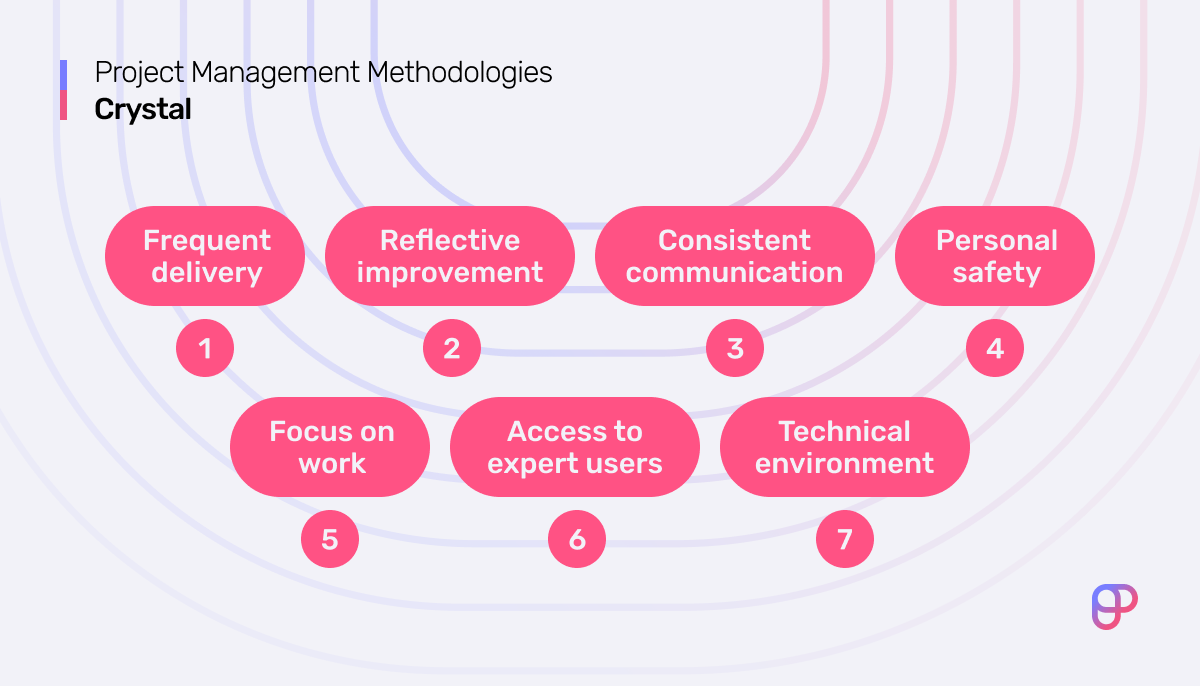
PM methodology #17: Feature-Driven Development (FDD)
FDD, in short: An iterative agile framework that emphasizes quality throughout all phases.
Feature-driven development (FDD) doesn’t enjoy the popularity of Scrum. Still, it is a noteworthy agile framework suitable for large and long-term software development projects.
FDD revolves around following best engineering practices to deliver quality software in short increments. It is a client-centric framework that focuses on developing new features both efficiently and consistently.
According to A Practical Guide to Feature-Driven Development, FDD is an adaptive and highly iterative process that:
- Highlights quality in each step,
- Aims to deliver tangible, functional results in frequent increments,
- Reduces disruption and overhead for developers by enabling meaningful status and progress reporting, and
- Provides easy-to-understand progress reports and real results early — which project stakeholders love to see.
The 5 steps in the FDD process are:
- Develop an overall model,
- Build a features list,
- Plan by feature,
- Design by feature, and
- Build by feature.
The best practices linked to FDD include:
- Saving time on uncovering which features and functions to add with domain object modeling,
- Developing by feature in short increments of time,
- Practicing individual class (code) ownership,
- Assigning sets of features to feature teams,
- Performing inspections to find defects,
- Identifying the features’ source code and documenting the changes (configuration management),
- Maintaining a regular build schedule, and
- Providing regular progress reports on the completed work.
Advantages of Feature-Driven Development
The most significant advantages of FDD are as follows:
- It’s a scalable framework that works well for complex, large, and long-term projects,
- FDD breaks down work into smaller, more manageable chunks and frequent iterations,
- The team communicates via documentation, so there are fewer meetings, and
- Domain object modeling provides an excellent insight into the overall project scope and context.
Disadvantages of Feature-Driven Development
However, FDD comes with some disadvantages too:
- It’s not suitable for small projects and is tricky to implement in older systems,
- You need a large enough team to cover all the FDD project roles,
- No shared team ownership,
- The client doesn’t get access to the documentation, and
- The project’s success is highly dependent on the chief programmer, who takes over multiple roles throughout the project.
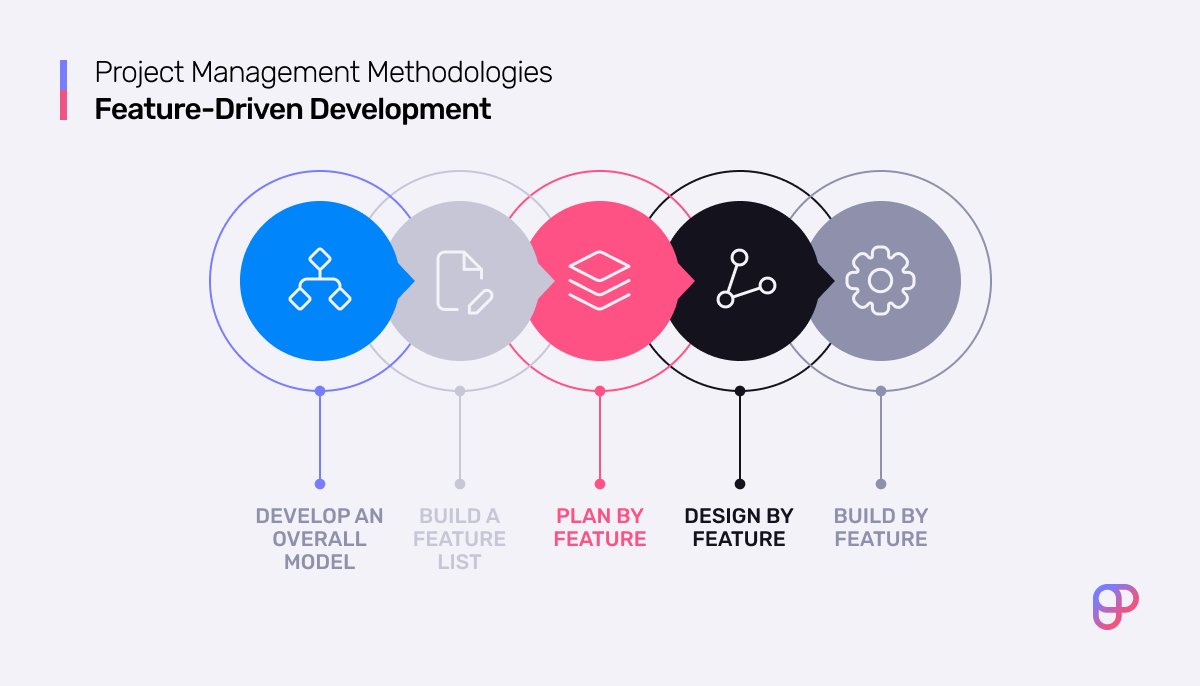
PM methodology #18: Dynamic Systems Development Method (DSDM)
DSDM, in short: An agile framework that focuses on governance and discipline throughout the project life cycle.
Dynamic Systems Development Method (DSDM) is an incremental and iterative agile approach to project management.
When it was first introduced, DSDM was used for software development, given that it was based on Rapid Application Development. Its purpose was to provide a more disciplined approach to software development.
Since then, DSDM has become a standalone framework suitable for other types of projects too. Its implementation is based on the following 8 principles:
- Focus on the business need,
- Deliver on time,
- Collaborate,
- Never compromise quality,
- Build incrementally,
- Develop iteratively,
- Communicate continuously, and
- Demonstrate control.
DSDM usually boils down to these 5 phases:
- Feasibility study,
- Business study,
- Functional model/prototype iteration,
- Design and build iteration, and
- Implementation.
Advantages of Dynamic Systems Development Method
The advantages of using DSDM for your projects are that:
- It focuses on the whole project, not just the product development and delivery,
- It’s fully scalable,
- It makes complex projects less risky,
- It’s easy to understand and thus implement,
- Real business value is one of its main goals, and
- It can be used alongside other agile approaches.
Disadvantages of Dynamic Systems Development Method
DSDM has a few disadvantages too:
- It can be expensive to implement, so it’s not ideal for smaller organizations with limited budgets,
- There’s a large management overhead, and
- Developers may find it creatively restricting.
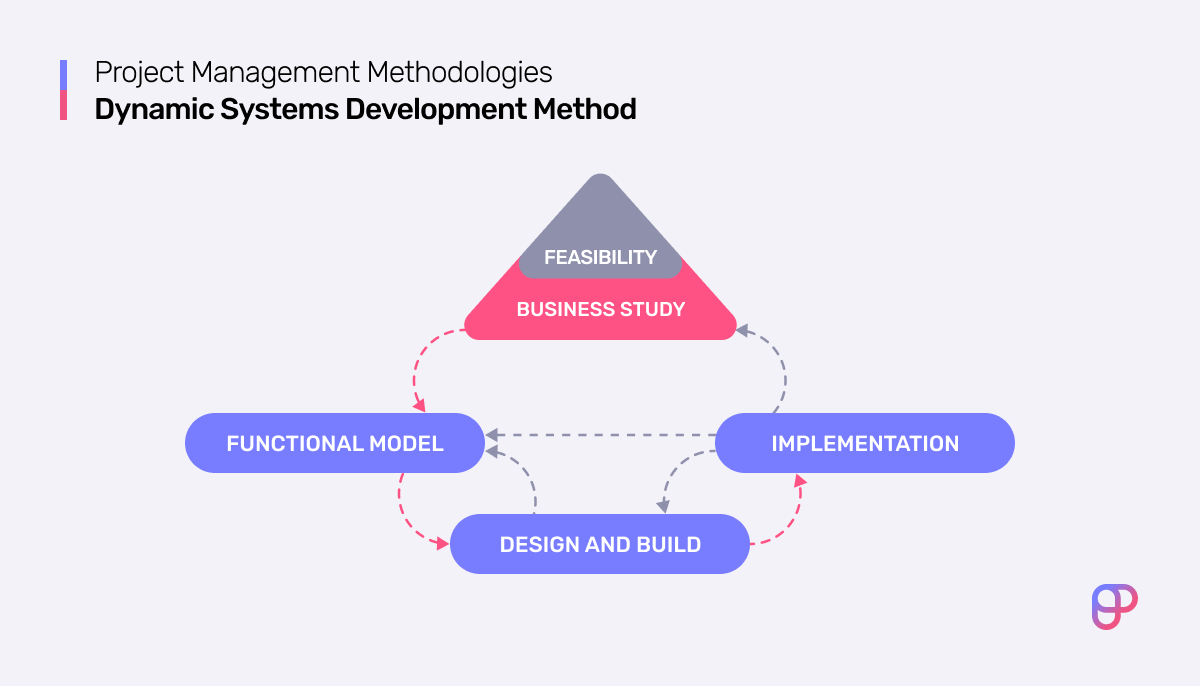
PM methodology #19: PRojects Integrating Sustainable Methods (PRiSM)
PRiSM, in short: Sustainable project management suitable for any sector or organization.
PRiSM™ (PRojects integrating Sustainable Methods) is a newer project management methodology that focuses on ensuring process and product sustainability.
The methodology encompasses sustainable development principles. These are used in combination with generally accepted PM principles.
PRiSM focuses on the entire asset lifecycle and employs a 5-step approach:
- Pre-project,
- Discovery,
- Design,
- Delivery, and
- Closure.
One of the major differences between PRiSM and traditional project management is that it requires an impact analysis. This analysis is done under the P5 standard, which helps manage and implement projects more sustainably.
In line with that, the PRiSM methodology focuses on these 6 principles for making sustainable changes:
- Commitment and accountability,
- Ethics and decision-making,
- Integration and transparency,
- Principle and values-based development,
- Social and ecological equity, and
- Economic prosperity.
Advantages of the PRiSM methodology
Some of the most important advantages of PRiSM include:
- Positive environmental impact (less waste, lower energy consumption, etc.), and
- Better company reputation due to being more socially responsible.
Disadvantages of the PRiSM methodology
The disadvantages of PRiSM are that:
- It’s expensive to implement since you need to be accredited for it, and
- It cannot be applied to just one project or team — the whole company must accept it and adhere to its principles and practices.
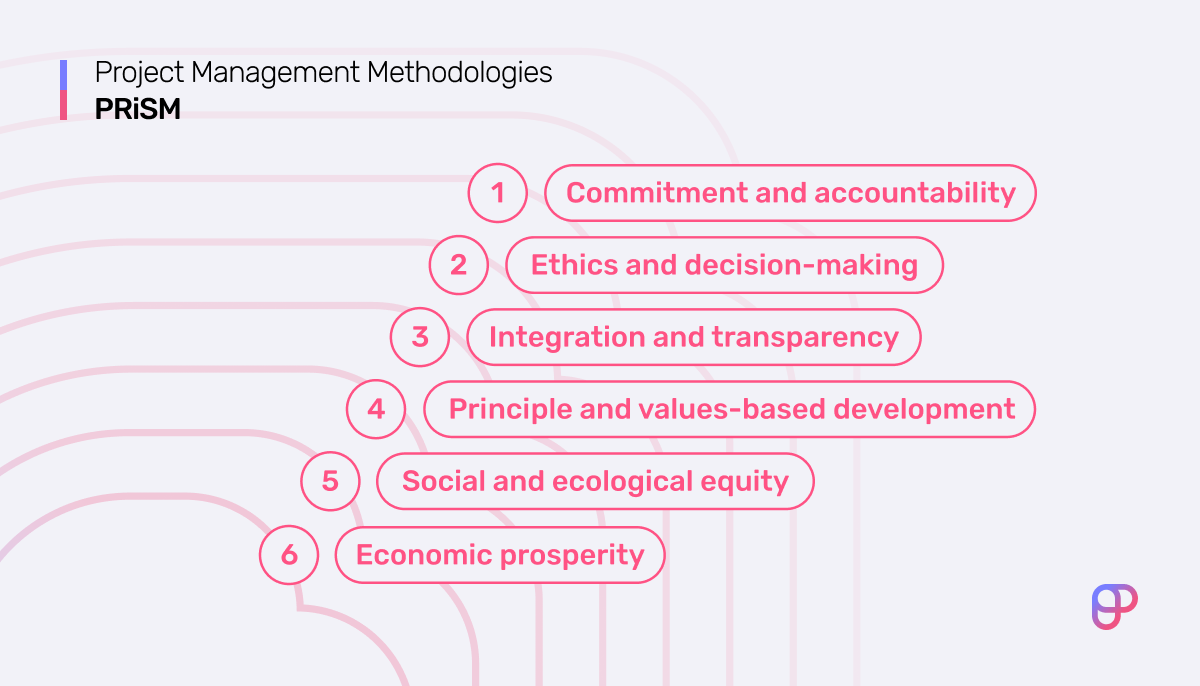
PM methodology #20: Event Chain Methodology (ECM)
ECM, in short: An uncertainty and risk-mitigating approach focusing on events and how they relate to each other in a project schedule.
As a schedule network analysis technique, Event Chain Methodology (ECM) is more of an approach that evaluates uncertainty related to project schedules.
The goals of ECM are to:
- Identify unforeseen events that may occur throughout the project life cycle,
- Come up with a plan to manage these events, and
- Track and review event interrelationships to see how they could impact the project schedule.
ECM revolves around the following 6 principles, as outlined in a paper on the application of ECM in schedule risk analysis:
- Moment of event and excitation,
- Event chains,
- Event chain diagrams,
- Monte Carlo analysis,
- Critical event chains, and
- Performance measurement.
Advantages of Event Chain Methodology
The most important advantages of using ECM is that it:
- Provides better insight into risk analysis and risk event probability,
- Allows for more accurate and simplified risk and uncertainty management, and
- Reduces cognitive and motivational biases linked to project scheduling.
Disadvantages of Event Chain Methodology
The disadvantages of ECM are as follows:
- It’s not an all-encompassing method but rather focuses on project scheduling, and
- It entails analyzing a significant amount of information.
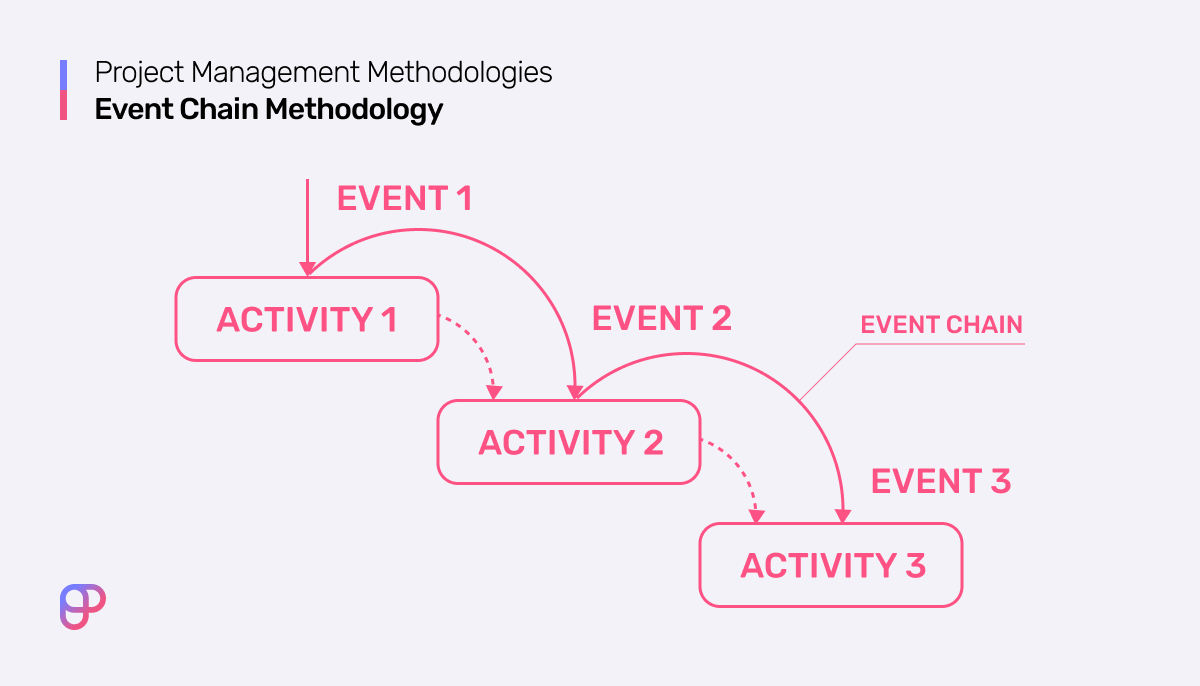
How to classify project management methodologies
According to a paper on the classification of project management methodologies, we can split PMMs into 2 categories:
- Project management methodologies — offer high-level project frameworks, and
- Application development methodologies — cover project design and development.
However, the same research classifies PMMs further according to specificity in 5 levels:
- Level 1 — Best practices, standards, and guidelines,
- Level 2 — Sector-specific methodology,
- Level 3 — Organization-specific, customized methodology,
- Level 4 — Project-specific methodology, and
- Level 5 — Individualized methodology.
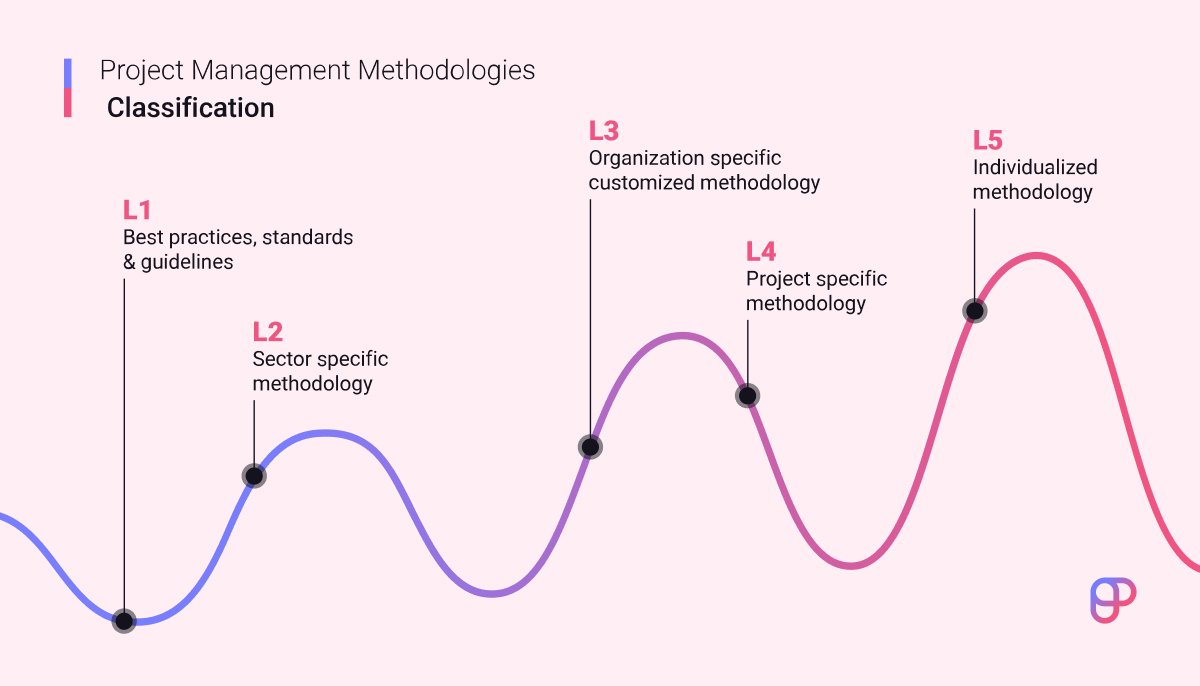
Let’s go through these levels in more detail.
Level #1 — Best practices, standards, and guidelines
This group is usually called “methodologies”, but that’s not entirely accurate. According to that same paper, many prominent authors believe that they are “encyclopedias” of best practices.
A true methodology has organizational or sector-specific characteristics — and that’s what these best practices lack.
Example of a Level 1 methodology — Project Management Institute’s Body of Knowledge (PMBOK)
Level #2 — Sector-specific methodology
Project management methodologies have to adapt to specific industry requirements, rules, and regulations. As Level 1 PMMs are no match for that purpose, they can be adapted into Level 2 PMMs.
To build a sector-specific methodology, we have to:
- Select suitable Level 1 PMM elements,
- Add sector-specific components to them, and
- Match them to the sector’s natural workflow.
The sector-specific components would stem from rules, regulations, and best practices of the said sector.
Therefore, Level 2 methodologies are not a one-size-fits-all solution. Instead, they’re specific to the sector they’re developed and applied in.
Example of a Level 2 methodology — Scrum.
Level #3 — Organization-specific, customized methodology
Level 3 PMMs are specially customized for a specific organization.
These methodologies are meant to support the nature and requirements of projects one particular organization deals with. Moreover, they are adapted for the organization’s internal structure and strategy.
Example of a Level 3 methodology — Rational Unified Process (RUP).
Level #4 — Project-specific methodology
At Level 4, we have a project management methodology adjusted to the needs of the particular types of projects an organization might pursue.
The aim of a Level 4 PMM is to:
- Provide a clear understanding of the project scope,
- Highlight everything that needs to be done,
- Clarify how the project fits in among the organization’s goals, and
- Lend tools and techniques to the project team that’ll take them to the finish line.
Projects in an organization can differ according to their nature and size, so level 4 PMMs must be scalable. Organizations cannot be expected to create a new methodology for each new project they handle.
Instead, the goal is to develop a methodology that’s organization and project-specific — but still flexible enough to be tailored to any given project.
Example of a Level 4 methodology — an adaptive approach such as Agile modified to fit company-specific projects.
Level #5 — Individualized methodology
At the high end of the specificity spectrum, we have an individualized methodology. This methodology caters to the needs of individual projects.
Dealing with any given project, in any environment, requires handling a certain volume of complexity. A Level 5 PMM gives all team members an efficient framework for how to fulfill their roles.
Example of Level 5 methodology — a project management methodology adjusted specifically to the needs of a company’s marketing team.
This categorization effectively resolves some of the confusion related to different project management approaches being deemed a “methodology”, “philosophy”, or a “framework”.
Instead, we can refer to all of these as methodologies, only with differing levels of specificity.
How to choose the right project management methodology
Here’s a breakdown of top PMMs to help you choose the ideal methodology for your team:

However, to choose the right project management methodology, it’s not enough just to compare them.
You should first start by evaluating your project goals and what could help you achieve them.
Once you’ve clarified that, you can go through known applications of several PMMs and choose the one most suited to your needs.
For instance, the expert we reached out to, David O’Brien, has a particular set of reasons he favors Scrum:

“I have worked within multiple methodologies and frameworks over the years. However, my favorite approach is Scrum. Scrum is very flexible and allows for incremental planning to take place. This creates a dynamic work environment where planning and implementation and reviewing are constantly happening. Everyone is learning, the team is bonding, and velocity/productivity is on the rise constantly.”
That said, George Earley, a PMP-certified project manager specializing in nonprofits and corporate project management, suggests that project managers don’t have to fixate on a particular methodology or framework, but can instead opt for a hybrid project management approach:

“Most trained project managers should be adaptable to a variety of frameworks so they can react based on the product they are developing. Working with project managers who can fit the right blend of hybrid approaches to the right project can be make-or-break to complicated projects and result in efficiency and savings when chosen correctly, or waste and delays if you get it wrong.”
The decision often boils down to what you want to accomplish with the PMM. To understand this, your team and you should ask yourselves these 5 questions:
- What are our goals for this project?
- What resources are available?
- What deadline are we working with?
- How many team members do we have and how can they contribute?
- What are the risks and rewards of using a certain methodology?
Question #1: What are our goals for this project?
If you’re trying to put a rocket into space, you probably won’t put “office decorations” at the top of your list of priorities. So, to know how to organize your approach to the project, you must decide on your project goals.
Example of asking about project goals
Mikayla leads a team of 4 software engineers as the Scrum Master. She has organized a meeting with clients and developers to discuss questions about project requirements, goals, resources, and deadlines.
The first and most important question she asks is:
“What should our goal be?”
In conversations with developers, who help determine what’s possible and what needs to be adjusted, clients finally settle on a goal — to build a ski gear e-commerce app.
Question #2: What resources are available?
Once you know what needs to be done, consider the resources you can get your hands on.
Your project resources will include:
- The approved budget for project realization,
- Logistics of putting the project into development and distribution, and
- The number and profile of the team members you’ll need.
Example of asking about available resources
After defining the main purpose of the project, Mikayla follows up by asking the clients:
“What resources are you willing to provide?”
When the clients respond, she asks her team members:
“What resources do we bring to the table?”
Following a discussion, the team can note down the total resources that will be available for the duration of the project.
Question #3: What deadlines are we working with?
Do you have a deadline, and if you do — how strict is it?
Is it just a vague notion of “we need to get this done at some point,” or are there dates and hours involved?
Vague and ill-defined project deadlines usually lead to little to no work being done. That said, deadlines that are too tight and have expectations of perfection can lead to employee burnout.
Balance is the key. Several project management methodologies suggest having a set deadline but allowing “buffer” room for mistakes.
Example of asking about deadlines
Mikayla now decides to ask the clients:
“When do you expect this app to launch? If unexpected delays occur, will this affect you greatly?”
The clients go on to say when they expect the app to be completed. However, they note that the date is not set in stone and can be pushed back if needed.
Question #4: How many team members do we have and how can they contribute?
Depending on how large the project is, you may need to gather a larger team around it.
Still, you need to go through each team member’s profile and determine how they can contribute. You should know more about their areas of expertise and level of experience before assigning them with appropriate roles.
Example of asking about team member contributions
With all prerequisites set, Mikayla first asks her team members:
“How would you like to contribute to this project?”
When she gets the answers, she decides if these contributions are appropriate.
At this point, she can also consider whether someone can take on additional responsibilities or delegate some to other team members.
Question #5: What are the risks and rewards of using a certain methodology?
When you’ve answered all of these questions, you can assess the methodologies and frameworks we listed in the previous section.
Creating a comparison chart would help you get a good overview of all the PMMs and their pros and cons. However, remember to do a risk and reward analysis as well to ensure your final choice is nothing short of ideal.
The PMM you go for should enable you to achieve your goals using the set resources and within the deadline.
Consider, however, whether your team would know how to use a certain PMM to its full potential.
Don’t just focus on the positives — think about how the PMM and your team members’ profile would complement each other.
Example of choosing a methodology
Having collected all the necessary information about her project, Mikayla goes on to create a detailed comparison chart.
She lists all the pros and cons of each potential PMM that could be used on the project. Furthermore, she considers the risks and rewards her team can expect from it.
In this case, she decides that the most appropriate approach would be — Scrumban.
The use of Kanban boards has proved to be effective, so this element aligns well with her team’s project development process.
She finds that Scrumban is also a perfect fit for effective communication in her team — and an approach her team is used to.
Better yet, Scrumban would enable her team to provide early project deliverables, which would be a big plus for the customers.
Here’s a quick reference guide to some of the most popular PMMs and the types of teams and projects they serve:
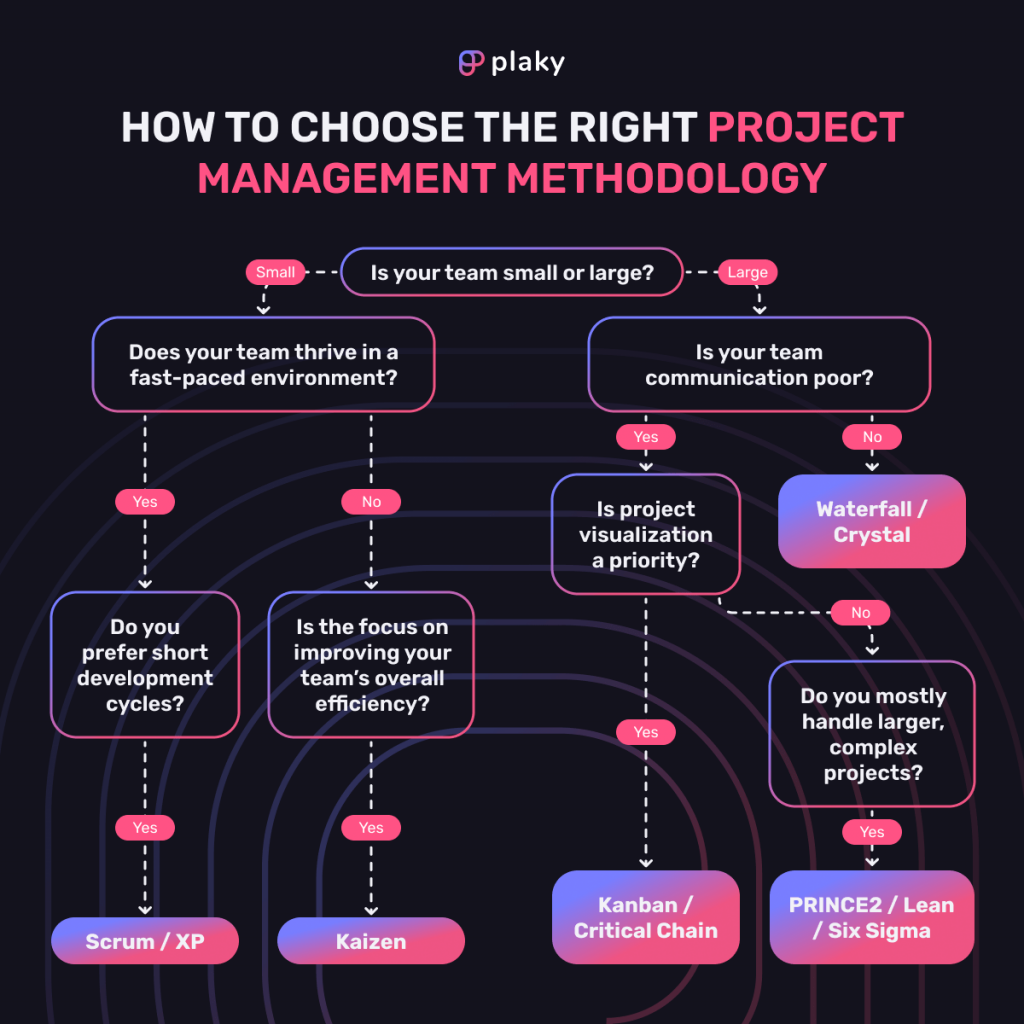
Conclusion: Choose a PMM that fits your project’s needs
Many popular project management methodologies seem like branches with a common root as they’re based around similar concepts. However, some have a completely unique approach.
When choosing a methodology, you must ensure its features are compatible with the type of project you wish to complete.
The first step is to have a clear understanding of your requirements.
Once you have that, you can compare the different approaches to determine which option fits you and your projects best.
The final step is to choose a project management software that makes using the approach practically effortless.
We’ve provided a basic overview of some of the more popular project management methodologies you can choose from today.
Hopefully, this guide will help you make a more informed decision and ensure your project’s needs align with the benefits of your chosen methodology.
📖 Project management methodologies are not the only concepts you need to understand to master successful project management — for a better understanding of common project management terminology, check out our Project Management Glossary of Terms.
References:
- Project Management Institute. (2021). A Guide to the Project Management Body of Knowledge (PMBOK® Guide)–Seventh Edition. Project Management Institute. https://www.goodreads.com/book/show/57910153-a-guide-to-the-project-management-body-of-knowledge-pmbok-guide-sev
- Manifesto for Agile Software Development. (n.d.). Retrieved March 13, 2023, from https://agilemanifesto.org/
- Highsmith, J. A. (2009). Agile Project Management: Creating Innovative Products, 2nd Edition. Addison-Wesley. https://www.goodreads.com/book/show/565477.Agile_Project_Management
- Sharma, Sheetal & Sarkar, Darothi & Gupta, Divya. (2012). Agile Processes and Methodologies: A Conceptual Study. International Journal on Computer Science and Engineering.
- The 2020 Scrum Guide™. Scrum Guides. (n.d.). Retrieved March 14, 2023, from https://scrumguides.org/scrum-guide.html
- Gonçalves, L. (2018). Scrum: The methodology to become more agile. Controlling & Management Review, 62(4), 40–42. https://doi.org/10.1007/s12176-018-0020-3
- Project Management Institute. (2017). Agile Practice Guide. https://www.goodreads.com/book/show/34525224-agile-practice-guide
- Ahmad, M. O., Markkula, J., & Oivo, M. (2013). Kanban in software development: A systematic literature review. 2013 39th Euromicro Conference on Software Engineering and Advanced Applications. https://doi.org/10.1109/seaa.2013.28
- Reddy, A. (2016). The Scrumban Revolution: Getting the Most Out of Agile, Scrum, and Lean Kanban. Addison-Wesley. https://www.goodreads.com/en/book/show/25953144
- Ganev, P. (n.d.). Advantages and disadvantages of using Scrum, Kanban and Scrumban for software development. Academia.edu. Retrieved March 14, 2023, from https://www.academia.edu/36983292/Peter_Ganev_Advantages_and_disadvantages_of_using_Scrum_Kanban_and_Scrumban_for_software_development.
- Janjić, V., Bogićević, J., & Krstić, B. (2019). Kaizen as a global business philosophy for continuous improvement of business performance. Ekonomika, 65(2), 13–25. https://doi.org/10.5937/ekonomika1902013j
- Womack, J. P., & Jones, D. T. (2003). Lean Thinking: Banish Waste and Create Wealth in Your Corporation. Simon & Schuster. https://www.goodreads.com/en/book/show/289467
- Thesing, T., Feldmann, C., & Burchardt, M. (2021). Agile versus Waterfall Project Management: Decision model for selecting the appropriate approach to a project. Procedia Computer Science, 181, 746–756. https://doi.org/10.1016/j.procs.2021.01.227
- What is Extreme Programming (XP)? Agile Alliance. (n.d.). Retrieved March 23, 2023, from https://www.agilealliance.org/glossary/xp/
- The history of PRINCE2. PRINCE2.com. (2017, February 6). Retrieved March 29, 2023, from https://www.prince2.com/eur/blog/the-history-of-prince2
- Williams, L. (2010). Agile software development methodologies and practices. Advances in Computers, 1–44. https://doi.org/10.1016/s0065-2458(10)80001-4
- Council for Six Sigma Certification/Harmony Living. (2018). Six Sigma: A Complete Step-by-Step Guide: A Complete Training & Reference Guide for White Belts, Yellow Belts, Green Belts, and Black Belts. https://www.goodreads.com/en/book/show/40971064
- Palmer, S. R., & Felsing, J. M. (2002). A Practical Guide to Feature-Driven Development. Prentice Hall PTR. https://www.goodreads.com/en/book/show/1268218
- Avlijaš, G., & Radunović, M. (2019). Application of Event Chain Methodology in Schedule Risk Analysis. European Project Management Journal, 9(2), 26–34. https://doi.org/10.18485/epmj.2019.9.2.3
- Chin, C., Spowage, A., & Yap, E. (2012). Project Management Methodologies: A Comparative Analysis. Journal for the Advancement of Performance Information and Value, 4(1), 106. https://doi.org/10.37265/japiv.v4i1.102
- Cockburn, A. (2004). Crystal Clear: A Human-Powered Methodology for Small Teams. Addison-Wesley. https://www.goodreads.com/book/show/3353.Crystal_Clear
 Project Management Hub
Project Management Hub 

